The Rise and Fall of the Greatest Luxury Liner of the Twentieth Century
The SS Normandie was the most luxurious ocean liner of its day. Sadly, that didn’t prevent her from meeting a cruel fate.

The ship represented the best of French design as well as engineering — it featured innovative turbo-electric engines and a revolutionary hull design. Its elaborate dining halls, lounges, and swimming pool were designed and built on a scale never before seen. Photos of its rooms hint at some of the lost glamour of this ultra-luxury liner.

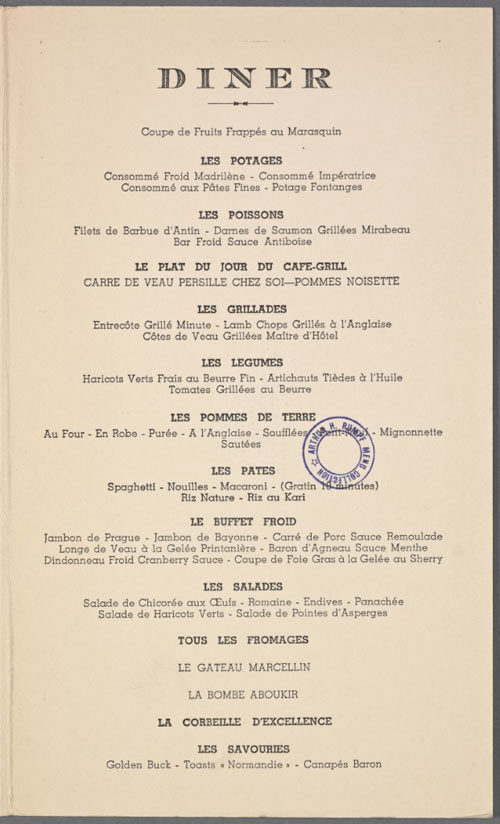
Click to Enlarge.
But like that other great luxury liner, the RMS Titanic, the Normandie was fated to meet repeatedly with bad luck and a short life.
The ship was launched in 1935, in the middle of a global depression, and never achieved the financial success its owners planned on. (The Normandie was really built for first-class passengers. With scant second- and third-class accommodations, the ship lost many passengers to its competitor, the RMS Queen Mary.)

When World War II began, the Normandie was docked in New York harbor. The owners decided to leave it there rather than let it be sunk by German submarines.
It was still there on May 16, 1941, when France was overrun by the Germans and the U.S. put the Normandie into protective custody.
It was still sitting in a New York dock when the U.S. entered the war. German-occupied France was now technically an enemy of the America. The Normandie was seized by the U.S. government, which proceeded to turn the world’s greatest luxury liner into a troop transport, renaming it the USS Lafayette.
The following February, a workman’s blowtorch started a fire onboard. The boat’s fire extinguishing system had been switched off and New York’s firefighters couldn’t get their equipment to work with the French system onboard. Standing on the dock, fire fighters sprayed the ship with water, which soon froze in the cold February air. The ice accumulated, making the Normandie top-heavy and eventually tipping it on its side.


On August 7, 1943, the ship was turned right-side-up again. But after sitting in water for a year and a half, the Normandie had deteriorated too far to make refitting worthwhile.
In 1946, after eleven years of unprofitable, interrupted service, the world’s greatest luxury liner was cut up for scrap metal.
Video of the SS Normandie, including her sea voyages, fire, and aftermath.
When the Post published “Resurrection of a Lady” in 1943, the Navy was still confident it would right the ship and return it to service. And while the Normandie never sailed again, the 1943 resurrection of 68,000 ton, 12-story, thousand-foot-long ship was a masterpiece of nautical engineering.
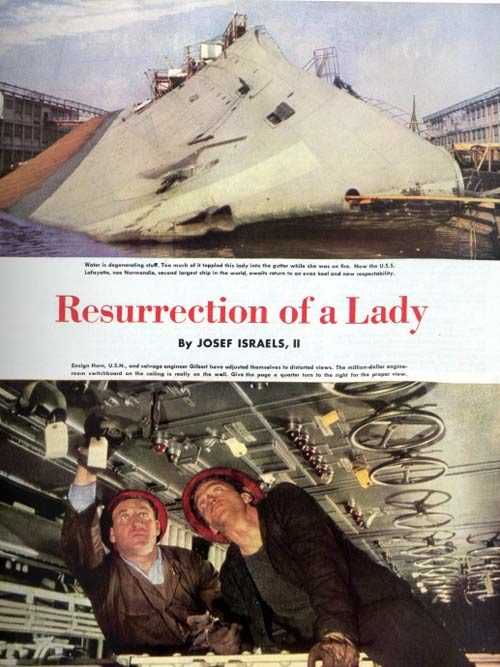
Representative Attacks Congress with Thesaurus
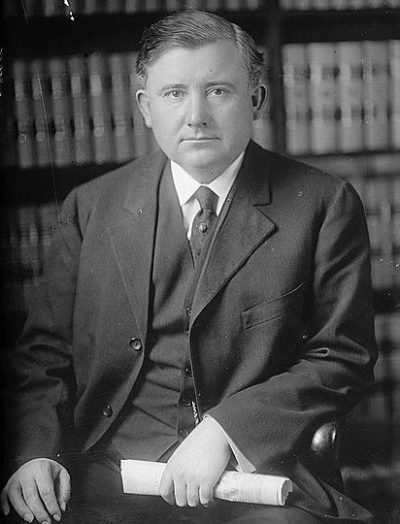
You might think that a freshman representative would be a little unsure of himself when he gave his first speech before Congress, that he might just take it easy in the beginning until he was more comfortable. Or, if you were Rep. Martin Littleton of New York, your first Congressional speech could be a 3-hour-and-40-minute-long disquisition full of linguistic gymnastics that shine a light in the deepest, darkest corners of the thesaurus.
Martin Littleton’s name isn’t widely known today, but at the beginning of the 20th century, he was a rising star in government and law. Born in Tennessee and raised in Texas, the largely self-taught lawyer moved to The Big Apple in 1896 and soon found himself embroiled in a number of high-profile — and highly lucrative — legal cases. He would eventually become one of the richest lawyers in the world.
Littleton was known for his oratory skills and was said to have a voice like a cello. In 1904, he was tapped to present the Democratic National Convention speech that introduced Alton B. Parker, the party’s eventual presidential nominee who would lose to Theodore Roosevelt. The experience gave him a taste of government life, and a taste wasn’t enough.
After holding a number of positions in local government and in the DNC, in 1910 he won the open congressional seat in New York’s First District despite the fact that the district was home to Theodore Roosevelt and was considered a Republican stronghold. Late in his term, he ran for a seat in the Senate but lost; thus he was a one-term congressman.
But that was all in the future when Littleton delivered his mammoth first speech during a debate about Arizona’s statehood. It caught the ear and imagination of the Post’s editors. In the following “Who’s Who” article about the man’s grandiloquence and badinage, the line between sarcasm and honest praise can be difficult to discern.
Need some help with Rep. Littleton’s multisyllabic lexicon? After the excerpt is a short glossary listing common synonyms for the more elaborate terms.
Who’s Who — And Why: Mellifluous Martin
Originally published July 1, 1911
Martin Littleton put on a show up at the House of Representatives the other afternoon that played to standing room only. He brought into the arena and exhibited it so all could see his unrivaled collection of trained adjectives and awe-inspiring nouns, sending them through various intricate evolutions — driving them single, double, in fours, sixes and tandem; forcing them to eat from his hand; combining them in picturesque pyramids and other palpitating postures; making them do death-defying flipflaps from one gigantic sentence to another, and proving conclusively the remarkable power of the observant mind and the tenacious memory over the wild denizens of the dictionary and the thesaurus.
“Well, well, good people,” said Martin, “here we are again, with our unparalleled aggregation of sibilant synonyms, antonomastic antonyms, contumelious caconyms and tuneful tropes. Nowhere else on earth can be found such a collection of apposite adjectives, adjutory adverbs, novitious nouns, and vorticular verbs. After years of patient exploration in the jeopardous jungles of Webster, the arenaceous acres of Funk-and-Wagnalls, and the refreshing rosetum of Roget, I shall exhibit before you this afternoon the fruits of my toil.”
And he marched them in, two by two, the antithesis and the hullabaloo, the hyperbole and the sweet goo-goo, the metaphor and the rhapsodoo; and everybody said there had been nothing like it since Morris Sheppard chortled for three hours and forty minutes in blank verse about equal rights for all and special privileges for none — which is deuced odd; for Sheppard comes from Texas — and so does Martin Littleton.
Nowhere else on earth can be found such a collection of apposite adjectives, adjutory adverbs, novitious nouns, and vorticular verbs.However, Texas is an extremely large state — an Empire in Herself, as all Texas orators say — and we needn’t worry about that phase of the subject; for though Texas is producing prose poets, she is also producing steers and onions and cotton and oil and other utilitarian stuff, and maintaining the balance of trade.
To get back to Martin and his show: It seems that Arizona, along about last year, received some three hundred thousand copies of Jonathan Bourne’s speech on representative government, which shows that Jonathan is a liberal young thing when it comes to sending out speeches — a regular speech-thrift — for there are only two hundred and four thousand people in the territory, or thereabout. Influenced, no doubt, by this generosity, the gentlemen who came to be engaged in the construction of a constitution for the state-to-be hastily stuck in the initiative, the referendum, and the recall, which, in turn, caused much debate when said constitution reached Congress.
Right here is where Martin bulged in. He had remained silent during the discussion of those various matters that had occupied the attention of the Democratic House until this moment; but when he saw the judiciary tottering to its fall, because of the recall provision in that constitution, he rushed to the defense of the ermine and brought his flock of apt and ardent — not to say alliterative — adjectives with him.
It was hard to do; but, after we disassociated the libretto of Martin’s argument from the music, we discovered that he feels deeply on the subject of the recall of judges, and is “agin” it to his guying dasp — no! — not that! — his dying gasp!
Alliterative Assistants
Martin’s speech contained a few other words than adjectives and nouns and adverbs, but they were comparatively unimportant. “They cut no signify,” as Charley Potter used to say. Eliminating them, this is the way Martin handled his rhetorical assistants:
“— misguided and malignant passions — recklessly accuse — stainless judge — lying litigant — mendacious effort — fabricated cause — unscrupulous hand — ruthless weapon — culpable confederates of the convicted criminal — irresponsible faction — corporate bandit — incorruptible court — agrarian agitator — substance and symbols of order — crooked creed — venal volunteers — pretentious program — empire of intrigue — deft and secret sign — swarms of satraps — daring demagogue — superficial sentiment — impugned, impeached, outraged and dishonored — shattered fame — foreclosed honor — spineless seeker — idle invertebrate — irresolute timeserver — sibilant hiss — merciless Mob!”
Of course there were many more, especially after Martin, who craftily withheld the effort for revision for several days, had had time to think adjectitiously; but herewith are enough to show what sort of an oratorical hairpin Martin is. I betray no confidence when I tell you Morris Sheppard rushed tumultuously from the hall and was seen throwing fits of jealousy beneath the statue of John J. Ingalls; and that Ollie James, although he appeared calm, was bitterly envious and furtively laughed a poisoned laugh of scorn that showed him to be hard-hit in his most vulnerable point — the vocal cords.
They crowded around Littleton and congratulated him, as well they might; for, since Charley Murphy refused to let New York send Bourke Cockran back to Congress, we have been worrying along with some mighty mediocre word trainers and exhibitors, and Martin seems to fill a longfelt want. And there is no doubt he will get better as he goes along, for he is only 40, or thereabout, and has years and years ahead of him to devote to the collection and exhibition of peerless and passionate phrases. A lot of galoots spend their time mourning because oratory is a lost art — but they needn’t worry. If oratory ever was lost — which every Southern statesman seeks to prove is untrue — Martin Littleton found it and has it safely tucked away in his jeans. Be calm! Martin is the Oratorical Kid.
A most engaging chap, too, is Martin, who has touched a good many high places in a short time and is sure to touch a good many more; for he has a lot of ability, an attractive personality, and is clean, courageous and not without the requisite confidence in himself. He is ambitious, too, and you never can tell where an ambitious man, backed by brains and an individuality, will land. He has a good reputation as a lawyer and as a worker, is an excellent campaigner, and not unversed in politics.
He was born in Tennessee, moved to Texas when he was 11 years old, and went to work. He was a sturdy young chap and did anything that came his way, from plowing to working as a brakeman on a railroad, getting such schooling as he could and studying law as opportunity offered. He was admitted to practice law when he was 19 and stayed in Texas until he was 24. Then he decided they needed him in New York and he went there. He discovered, during the first few years of his New York experience, that if they needed him they were very successful in concealing the fact — but he held on; and, presently, after injecting himself skillfully into local politics, was elected president of the Borough of Brooklyn, which position he held during the years 1904 and 1905.
He had done a considerable amount of plain and fancy orating in New York, but his first national chance was when they put him up to nominate Alton B. Parker for President — in St. Louis in 1904. The nominating part of it was all right, for Littleton made a big speech; but the election part of it was a sad affair. However, that wasn’t Littleton’s fault; and he kept on growing in public estimation in New York, devoting himself to the law, with politics as a side line. Last fall he was nominated for Congress in the First New York District, which is inhabited by Colonel Theodore Roosevelt and was represented by W. W. Cocks. Littleton defeated Cocks by some 6,000 votes and just ripped things up in Oyster Bay, where the Colonel lives and votes.
During the course of the senatorial deadlock in New York State he offered himself as a solution of the problem, but they didn’t solve it that way, and he came to Congress, where they put him on the Committee on Judiciary and the Committee on Patents — and where, as related here, he recently took occasion to make a few remarks concerning the recall of judges.
His debut was a success, and from time to time we may expect him to appear in the arena and make the welkin ring. So far as that first speech is concerned, all will freely admit it was a corker; but it seems to us he slipped just one cog. He referred to the “corporate bandit.” Nix, Martin! You can do better than that. Why not “corporate corsair” or “business bandit”? A rising young orator never should cramp his style with any such harsh combination as “corporate bandit.” Apt alliteration’s artful aid amplifies argument and augments appeal. Giddap! Dobbin, giddap! We must away to town.
Glossary of Synonyms
Adjectitiously: additively, with an eye toward expansion
Adjutory: helpful
Antonomastic: titular, epithetical [Antonomasia is the use of the name of an office in place of a person’s actual name, such as referring to a judge as “your honor”]
Apposite: pertinent, appropriate
Ardent: passionate
Arenaceous: sandy
Badinage: wordplay, repartee
Caconym: (of a word) objectionable
Contumelious: abusive, humiliating
Corker: conclusive argument
Demagogue: disingenuous politician, one who attains power through false promises and manipulation of popular prejudices
Denizen: resident, inhabitant
Dobbin: workhorse
Ermine: the office or dignity of a judge (from the idea that, at least in England, state robes were ornamented with the fur of the ermine, a type of weasel)
Galoot: codger, miser
Grandiloquence: bluster, bravado
Impugn: opposed, attacked verbally
Jeopardous: perilous
Lexicon: vocabulary
Libretto: lyrics, the words of an opera
Mellifluous: sweet, especially of a voice or melody
Mendacious: false, dishonest
Novitious: new, invented
Rosetum: rose garden
Satrap: petty despot
Sibilant: hissing, abundant in s and z sounds
Tumultuously: agitatedly, noisily
Unscrupulous: unethical
Vorticular: whirling (like a vortex)
Welkin: the sky, the dome of heaven
News of the Week: Everything’s Frozen, Fieri’s Is Closing, and Hydrox Cookies Are Still Around
Walking in a Winter Wonderland
Oh boy is it cold. It’s North Pole cold. It’s Swanson-TV-dinner-that’s-been-in-the-back-of-your-freezer-for-a-year cold. It’s cold like you read about in Cold Illustrated, the magazine for people who like when it’s cold. As I type these words, it’s 19 degrees in the Boston area, which is actually balmy, considering we’ve been dealing with single-digit temps and incredible wind chills the past couple of weeks. When you read this, we’ll probably be under a foot of snow, thanks to something called a “bombogenesis” or “bomb cyclone”, the entire region encrusted in layers of white and ice.
That’s how Niagara Falls looks right now, as these stunning pictures show. Erie, Pennsylvania has been buried in snow for days, breaking a record, and more is on the way. And the brutal cold in Minneapolis is making driving and walking really difficult.
This is the part where I make a contrast with the snow and tell you what it’s like in places like Florida and Georgia, but sorry, it’s snowing there too.
Flavortown Closes
If you watch the Food Network at all, you’ll notice that Guy Fieri is everywhere. He’s trying to beat Bobby Flay for the number of shows hosted. That number currently hovers around 47. But one place Fieri will no longer be seen is New York City’s Times Square.
Guy’s American Kitchen & Bar in Times Square closed for good after New Year’s Eve. The place opened in 2012 and was quite popular with tourists.
No word from Fieri on why he’s closing the restaurant. The devastating zero-star review from Pete Wells at The New York Times, where Wells asked Fieri a series of questions about the food and the service, probably didn’t help, but I can’t imagine that it’s the reason the place has closed. That was five years ago.
Fieri still has several other restaurants around the world.
Rockwell’s Door Opens
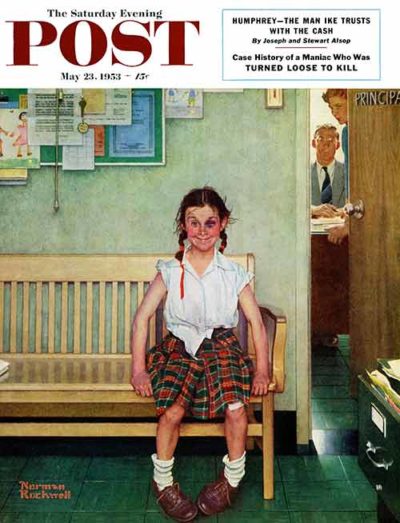
Norman Rockwell
From May 23, 1953
The door seen in the iconic Norman Rockwell Post cover Triumph in Defeat (some might know it as the Shiner or Girl with the Black Eye painting) is being preserved.
The Cambridge, New York, school that served as the setting for the painting is being renovated, and teacher Steve Butz wanted to make sure the principal’s office door seen in the painting would survive. It’s now part of a special exhibit, housed in glass near the school’s library.
By the way, the girl in the painting, the 11-year-old daughter of Rockwell’s lawyer, didn’t really have a black eye. Rockwell had to duplicate what a black eye looked like but was having trouble with the color. So he put out a call for someone who had a black eye, and a Massachusetts boy named Tommy just happened to have two of them. His dad drove him to the school so Rockwell could see what the eyes looked like.
The moral to this story is clear: Kids should get into fights so they can be part of American history.
How Do You Say “2018”?
Maybe my memory is wrong, but I remember when everyone used to pronounce a year like 2018 as “two thousand eighteen.” I don’t remember anyone saying “twenty-oh-four”; it was “two thousand four” (or maybe “two thousand and four”). But I’ve noticed that it’s now more common to hear “twenty eighteen,” and it’s something I don’t quite get. While you could make the logical argument that this pronunciation keeps it consistent with decades past (“nineteen seventy-two,” “nineteen ninety-nine,” etc.), I still refuse to do it. I’m not going to say “twenty eighteen.”
After all, what’s the title of that Stanley Kubrick movie about space?
Gone Away Is the Blue Bird
The Library of Congress has announced that it will no longer keep an archive of every single public tweet that is posted on Twitter. What, you didn’t know that the Library of Congress was keeping an archive of every tweet?
On January 1, the LOC began preserving tweets on a selective basis — only the ones they think are worth keeping as a historical record of the online service. But don’t worry, the picture you posted of that really great ham sandwich you had in the summer of 2013 will still be in the Library of Congress for future scholars to study.
People We Lost in 2017
A lot of publications and news shows do a year-end roundup of all of the famous people who died during the year, but no one does it better than CBS Sunday Morning.
As an addendum to that extensive list, I would add Maura Jacobson, who created crossword puzzles for places like New York magazine and The New York Times for more than 30 years. She died Christmas Day at the age of 91. And Peggy Cummins, the actress best known for her role in the classic crime film Gun Crazy — which was based on a MacKinlay Kantor short story published in the February 3, 1940, issue of the Post — who died last Friday at the age of 92.
The Best and the Worst
Best: I know we’re well into two thousand eighteen, but how about one more look back at last year? Dave Barry’s Year in Review is always a great, funny way to end the year.
Worst: I mentioned CBS Sunday Morning earlier, and former host Charles Osgood announced this week that he is retiring from his four-times-a-day radio show The Osgood Files. In this interview with Alex Silverman at WCBS, Osgood says that he’s not only dealing with two types of cancer, but his family has noticed he has slowed down a bit. He says he’ll still do a podcast now and then, but he’s no longer going to do a regular show. Osgood has been at WCBS for 50 years.
In the interview, Osgood mentions how great a country America is, and here’s a piece he wrote for the Post in 2009 that expands on that.
This Week in History
Hydrox Cookies Debut (January 1, 1910)
Did you know that Hydrox cookies are still around? I haven’t noticed them on my local store shelves in years — I would have bought them to refresh my memory on how they compare to Oreos — but you can still buy them in stores and online, thanks to a clever businessman who scooped up the Hydrox trademark for his company Leaf Brands when it became available a few years ago.
President George Washington Delivers First State of the Union (January 4, 1790)
It was originally called a Message to a Joint Session of Congress, and Washington made it from Federal Hall in New York City.
This Week in Saturday Evening Post History: Hot Pursuit Turns Cold (January 3, 1959)
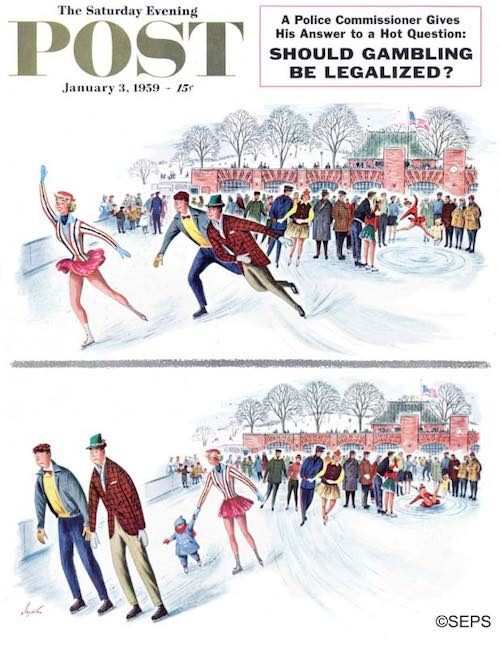
Constantin Alajalov
January 3, 1959
Hot Pursuit Turns Cold
Constantin Alajalov
January 3, 1959
I usually understand magazine covers, but this one has me baffled. It’s from Constantin Alajálov and depicts a winter skating scene. I get that the two men are trying to pursue the attractive female on skates in the first panel, but in the second panel, she’s behind the men and suddenly has a child. It’s almost as if there’s a panel of the painting missing. Or does the female skater have magical powers a la Samantha Stephens on Bewitched? Or maybe I’m just a dolt who doesn’t understand it? (Note: Me being a dolt is a distinct possibility.)
Later On, We’ll Conspire … As We Dream by the Fire
I had a post all set to celebrate National Whipped Cream Day, which is today. But then I thought, who the heck wants to think about frozen desserts when half the country feels like a frozen dessert? This is a time for cozy fires and comfort foods, so I decided to help you out by celebrating something I’ve talked about in past years: National Soup Month.
Chicken noodle soup is the ultimate winter soup, and here’s Curtis Stone’s recipe. How about something from Melissa d’Arabian, who isn’t on half as many Food Network shows as Guy Fieri? Here’s her recipe for Rich Roasted Tomato Soup. My mom used to love split pea soup, and here’s a recipe for a classic onion soup from Rachael Ray, with a good amount of golden cheese melted on the top of crusty bread.
Stay warm!
Next Week’s Holidays and Events
Epiphany (January 6)
The Christian holiday “celebrates the revelation of God incarnate as Jesus Christ” 12 days after Christmas. Don’t be surprised if you awaken to the sound of drummers drumming this Saturday, because recognition of Epiphany is the source of that incessant carol “The Twelve Day of Christmas.” It’s also the day that many families consider the official end of the Christmas season and take down their trees.
Letter Writing Week (January 7–13)
I’ve mentioned many times in this column how much I think everyone should get off social media and start writing letters again, so this is the perfect week to start doing just that. And if you need some reasons why you should keep writing letters, read Nicholas Gilmore’s excellent piece.
Vintage Ads: Remembering the 20th Century Limited
Once considered the greatest train in the world, The 20th Century Limited made its last run from New York to Chicago fifty years ago, on December 2, 1967.
When it departed from New York’s Grand Central Terminal at 6:00 PM that Saturday night, it was obvious why the train was ending 65-year run. The once prestigious train, which for decades had been the first choice for the rich and famous on their way to New York, was only half full.
Passengers who boarded the train would have noticed that memento hunters had been at work. The iconic red-and-gray curtain that hung over the Limited’s gate had already been stolen. Menus in the dining car were quickly disappearing. The police were guarding the train’s famous 100-yard red carpet, with its distinctive art nouveau logo, to ensure it didn’t disappear as well. It helped distinguish the Limited from every other train pulling out of Grand Central and it originated the term “red carpet treatment.”

By 1911, the New York Central Railroad could afford a full page ad in the Post, boasting that it could take passengers between New York and Chicago in 18 hours.
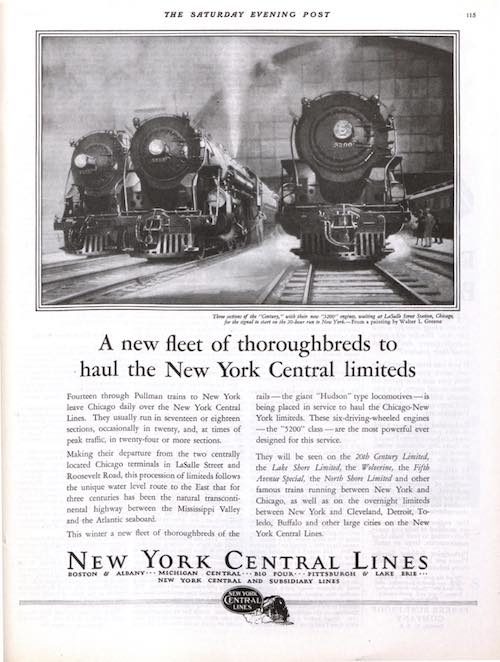
Passengers enjoyed luxurious décor and gourmet dining that featured lobster and filet mignon. Cocktails were served in three club cars, though employees claimed that half the drinks were consumed in private rooms or suites.
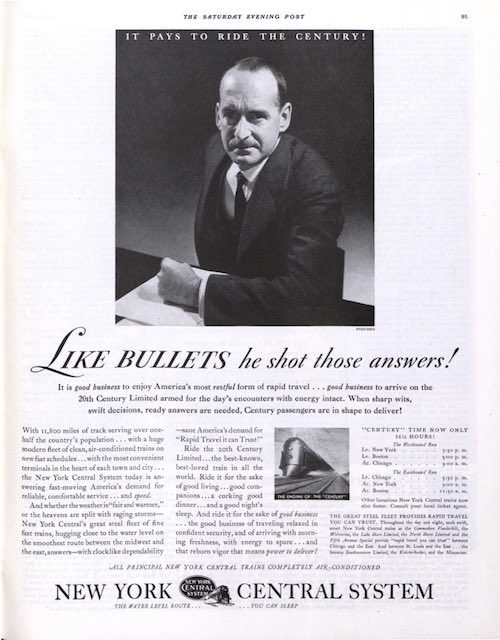
Like everyone else, the railroads saw revenues fall during the Depression. Where the Limited had once presented itself as the fastest and most luxurious route, in 1936 it advertised itself as the most practical. Its commercial passengers, they argued, were so well rested after 16 hours of travel, they were better prepared for business.
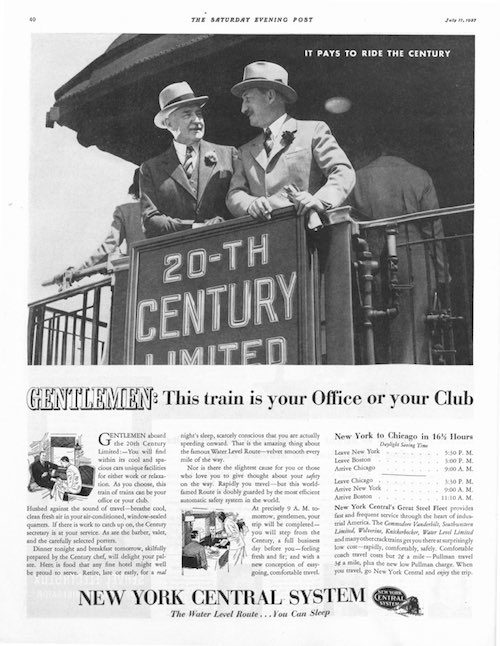
The Limited could also be the ultimate men’s club, a place for male business or bonding.

In 1938, the New York Central rolled out its ultra-modern streamliner.
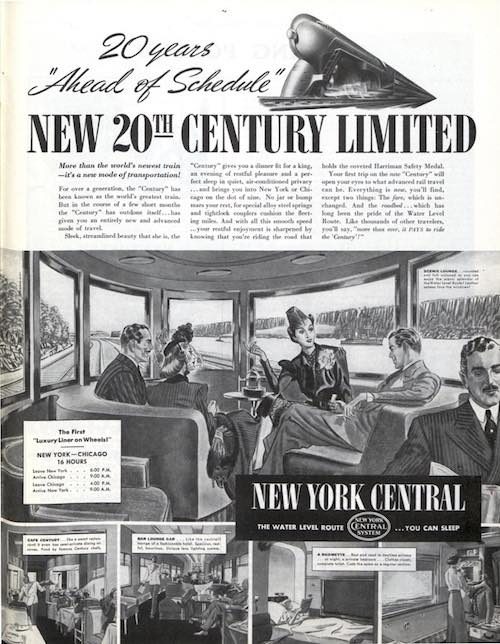
The streamliner featured a new observation lounge and passenger compartments with individual air-conditioning and bathrooms.

The railroad assured passengers that, despite losing employees to the war, there was no drop in the quality of service on the Limited.
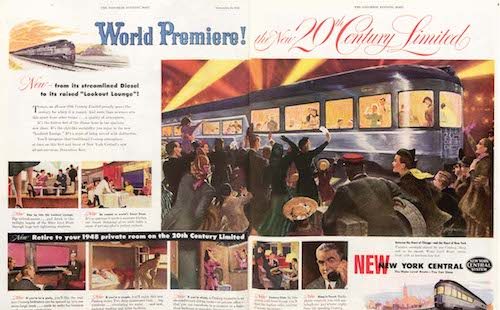
In 1948, the Limited got another new look from the same designer who created the streamliner. The new Limited switched to diesel power and its modernized furnishings now included phone service on board.

The Limited liked to emphasize its “Water Level Route” that followed the shore of Lake Erie and the Hudson River. It was a more restful ride, the railroad argued, than the route taken by its competitor, The Pennsylvania Railroad, which had to cross mountains.
Train travel declined after World War II, and air travel started becoming more affordable. When the New York Central decided to end the legendary rail service, many of its long-time passengers took one last ride. The last run of the Limited marked the end of an era.
Weaving a New Life in America

Photo courtesy of Kathleen Garrett
The art of crocheting was her passport from Sicily to upstate New York.
The winter rains had subsided for the moment, but the coastal night air remained chilly and damp. My rent-controlled apartment, with its lack of insulation, mirrored the outside evening temperature as I sat at my desk, struggling to meet a self-imposed deadline. Shoes aren’t allowed in my home, not even for me, and with porous window seals in this old building and its wooden floors, my cold feet needed something warm to cover them.
I’d been away from Santa Monica for quite some time and had yet to fully unpack and organize my apartment. The floor of my closet was a wreck. Piles of miscellaneous footwear and chaos lay everywhere as I dug through debris in the hope of finding a matching pair of slippers.
There, stuck in the corner under the shoe rack and covered in dust, lay a forgotten pair of brightly colored orange woolen slipper-socks my Sicilian grandmother, Teresa, knitted well over a quarter-century ago. I salvaged the little booties, quickly put them on, and was struck by the gems on my feet. The knitting was close to perfect, the craftsmanship remarkable, and the bold orange and light-green yarn woven throughout showed such a playful humor that it made me smile.
Everyone in the family — her children, grandchildren, and great-grandchildren — was given my grandmother Teresa’s crocheted wares. Sometimes they were given as birthday or Christmas gifts, but most of the time, when she finished a project, she would offer the crafted article to whomever wanted it. In my youth, I considered her creations passé and unfashionable. But as the booties instantly warmed my feet, I examined these meticulously made items more closely, marveling at their workmanship and my grandmother’s gumption.
My eye caught another woolen object sticking out from the mound of wreckage at the bottom of the closet. Shoving shoes, boots, and whatever else in that pile aside, I pulled out a knitted wire hanger. Years before the velvet, nonslip hangers became popular, my resourceful grandma took metal hangers and crocheted over them. This woolen covering not only prevents clothes from falling off, but also makes the unsightly wire attractive, with bright, multicolored yarn intricately stitched around it.
Making the best out of unlovely things was a particular skill of Teresa Munafo, born in the small town of Fondachelli-Fantina, Sicily, in 1901. Her father bought cheese from local farmers, picked filbert nuts, and sold them in the coastal city of Messina, some 80 miles away, while her mother raised their four small children. In 1908, the massive Messina earthquake struck southern Italy, killing her father and leaving the family destitute. Teresa’s education never went beyond the third grade, as she and her siblings had to quit school and work picking crops for pennies. At night and whenever there was free time, she and her sister would weave and crochet garments and coverlets for the family.
The art of crocheting developed throughout the world at different periods of time. In Italy, it dates back to the 16th century, and according to Danish researcher Lis Paludan, “crocheting was known as ‘nun’s work’ or ‘nun’s lace,’ where it was worked by nuns for church textiles.”
Teresa’s older brother, at 14, left to find work in America and sent what little money he earned back to the family. Her sister married at 14 or 15 (the exact age is unclear), had two children, and then died of a heart attack at 19.
Teresa found herself pregnant out of wedlock by her first cousin, Carmelo Salamone, when she was 19 — a scandal in her strict Roman Catholic family and community. But Carmelo was unaware he was to become a father and shipped off with his brothers and male cousins in 1920 for America. Learning of Teresa’s condition, he was forced to return to Italy to marry her. Her older brother scornfully asked before her wedding, “Aren’t you ashamed to wear a veil?” referring to its symbolism of purity, which he felt she no longer deserved. Carmelo then went back to America and, two years later, sent for Teresa and their new son to join him. They settled in a large Italian community in Schenectady, New York, which is where Teresa further honed her skills with knitting needles, learned English, and became a businesswoman.
Hanging in the back of my closet was a deep burgundy, button-down, knitted sweater my grandmother made when I was a teenager — not much younger than she’d been when she became pregnant with her first child. At that age, I didn’t think this handcrafted garment was trendy enough to wear, though I couldn’t part with it either. In examining the cardigan more closely on that damp night, I realized its three-quarter sleeves and scoop neck were not out of date at all, but rather fashionable, so I put it on. The softness and warmth of the wool caressed me as though it were the loving embrace of my long-departed grandmother.
Although Teresa had only minimal education, she possessed the work ethic and ingenuity of an executive. When the Great Depression rocked the world, the migrant community of Mont Pleasant, a subsection of Schenectady, was hard hit. Basic household items, such as blankets and curtains, could not be purchased in stores, so the women of the neighborhood sewed, knitted, and crocheted in groups, making these necessities for one another.
Carmelo’s driveway, and the women worked together to create comforters and window dressings. A horse and wagon came around selling thread, yarn, and other needed materials for their projects. This gave Teresa the idea to purchase the materials from wholesalers in New York City and sell them for a small profit to the neighborhood paisans.
As the demand for material grew, so did my grandmother’s need for a supply room. She took over one of her sons’ bedrooms, moving him into his two brothers’ tight sleeping quarters, and filled the new storage space with shelves of material from floor to ceiling. Business went so well that she and her husband decided to buy the apartment building across the street and convert it into a department store, and thus the family business was born.

Photo courtesy Kathleen Garrett
The beautiful afghan stretching across my queen-size bed is her largest and one of my most treasured heirlooms. It is white with little granny squares of multicolored flowers knitted throughout. This particular type of blanket was a special work. My uncle offered me his one day since he had so many other knitted throws and blankets she had made. I was thrilled to possess such an artistic treasure.
Looking at the stitching more closely, my grandmother’s nimble fingers appear like a vision, rhythmically and supplely knitting in rapid precision. I recall her barely looking at her hands as her fingers swiftly moved the yarn in and around the needles, creating intricate patterns and designs. She never used a knitting outline or instructions of any kind. Nor did she ever count aloud or write down the stitch number. She just seemed to know how many knits and purls, traveling, twisted, and slip stitches she had done. She knitted blankets, sweaters, bedspreads, booties, baby caps, mittens. She crocheted tablecloths, bedlinens, doilies, and handkerchiefs. Even pocketbooks. There wasn’t anything my grandma’s knitting needles couldn’t create.
Being a disciplined and industrious woman, and believing idle hands are the devil’s workshop, Grandma Teresa attempted to instill her work ethic in her granddaughters, insisting we learn how to knit. But my adolescent temperament couldn’t appreciate the skillfulness and imagination of her work, nor how useful this craft could be. Years later, while performing in a one-woman show, I had to knit a sweater in a scene and thought of all those times she tried in vain to teach me. Fortunately for me and the show, my character knitted badly.
Another of her handmade woolen blankets rests on the back of my sofa. It is a motif — loud, free, and fanciful, with wide lime green and hot pink stripes running throughout. In looking at these whimsical objects, I suddenly realized perhaps this was the only way my grandmother, a serious and formidable woman, could express the imaginative, childlike joviality that was kept bottled within her.
Grandma Teresa was not always as warm as her creations. She did not spoil her grandchildren with outward affection, nor let the grandkids get away with behavior their parents would not allow. Perhaps she never knew what it was like to be a fancy-free child laughing and playing without a care in the world. Maybe the only way she knew to express her love to us kids was to insist on discipline, instill work habits, and give us the tools that brought her a successful life.
Today, when I am wrapped in her afghans or my feet are warmed by her knitted booties, I am reminded of my grandmother, Teresa Munafo Salamone — and inspired by her mettle to come to a new land, taking on a different language, culture, and life, and having the courage to never stop creating.
Kathleen Garrett is an actress, writer, and voiceover talent who works in Los Angeles and New York City. Originally appeared at Zócalo Public Square. This essay is part of What It Means to Be American, a partnership of the Smithsonian’s National Museum of American History and Zócalo Public Square.
This article is featured in the November/December 2017 issue of The Saturday Evening Post. Subscribe to the magazine for more art, inspiring stories, fiction, humor, and features from our archives.
News of the Week: The Rockefeller Tree, Dangerous Toys, and Little Debbie Needs Your Help!
The Tree Has Arrived
How was your week? I pulled a muscle in my neck, had to get my stove fixed, and for the 32nd year in a row I wasn’t named People’s Sexiest Man Alive. But there is good news: The Christmas season has begun.
You might think the season officially begins when the red and green candy appears on supermarket shelves or when the department stores hang their wreaths, but it officially officially begins when the Christmas tree arrives on a truck in front of Rockefeller Center. It’s almost as if you’re given permission to call it the holiday season and listen to Christmas music when the big tree gets to New York City. Fa-la-la-la-la, la-la-la-la.
The lighting of the 75-foot Norway spruce happens the night of November 29 on NBC.
Toys: The Good, the Bad, and the Ugly

Two different toy-related lists were released this week, one naughty and one nice.
The consumer safety group WATCH (World Against Toys Causing Harm, which sounds like the name of a secret team of superheroes) has released their annual list of the 10 most dangerous toys. This year’s list includes the Wonder Woman Battle-Action Sword, Jetts Heel Wheels, the Slackers Slackline Classic Kit, and the Itty Bittys Baby Plush Stacking Toy. Yes, even toys with the word “plush” in them can be dangerous.
But this week also saw the induction of several toys into the National Toy Hall of Fame. The three inductees are the board game Clue, Wiffle Balls, and paper airplanes. What finalists didn’t make it this year? My Little Pony, Risk, play food (toys that look like food), Transformers, PEZ dispensers, UNO, and sand.
That’s right, sand was a finalist this year. Sand.
Where Will Amazon Build Their New HQ?
That’s the big question every state is asking these days. Well, maybe not Hawaii, but many of the other 49 states. Amazon is going to build a second headquarters, and many cities have submitted plans to the online retailer with their best pitch.
The Wall Street Journal has done a study to figure out which city would be the best fit for Amazon, taking into account such criteria as cost of living, taxes, access to college graduates and tech help, and culture. The paper says that the top three contenders are Dallas, Boston, and Washington, D.C.
What the company should do is build it at the North Pole. There’s plenty of land, there might be some elves looking for work, and people sort of think of Amazon as Santa Claus already.
It Better Not Be the Oatmeal Cremes
Which one? pic.twitter.com/L0JNW7SAVL
— Little Debbie (@LittleDebbie) November 8, 2017
That’s a tweet the snack company sent out recently. They’re getting rid of one of their popular snacks, and they want to know from you which one should go (actually, they say “one gotta go” and boy is that an odd phrase). Of course, there’s no real reason why they have to get rid of one of the snacks. It’s clearly a publicity thing, something they want to become a “meme” and “go viral.” Writer R. L. Stine likes the Oatmeal Creme Pies, and William Shatner wants them all to stick around.
I think it’s obvious which one will be hitting the unemployment line. It’s the Honey Buns. No one has a heart black enough to get rid of a cake shaped like a Christmas tree, Oatmeal Creme Pies are too delicious, and Nutty Buddy rhymes, and everyone likes when foods rhyme. So Honey Buns gotta go.
RIP Liz Smith
Liz Smith was a journalist for 60 years and is best known for writing about celebrities and the culture of Hollywood and New York for various newspapers from 1976 to 2009, when she was let go from The New York Post at age 86. She died Sunday at the age of 94.
Here’s a great video interview with Smith at The New York Times, where she talks about her experiences with people like Frank Sinatra, Donald Trump, Katharine Hepburn, and Barbara Walters.
Casablanca at 75
The classic Humphrey Bogart/Ingrid Bergman drama premiered in New York in November of 1942. Bill Newcott talks about the film in this week’s edition of “Movies for the Rest of Us,” and on Sunday, CBS Sunday Morning did a story about the film and its dedicated fans, including interviews with the children of stars Bogart, Claude Rains, and Paul Henreid.
This Week in History
George S. Patton Born (November 11, 1885)
Post Archive Director Jeff Nilsson explains how General Patton was part of the century’s best-kept secret.
The Star Wars Holiday Special Airs (November 17, 1978)
I’m not even sure if this has been seen on television since it first aired. Maybe only a few times or in snippets here and there. But thanks to YouTube, you can watch the whole thing. Along with Harrison Ford, Mark Hamill, and Carrie Fisher, you get sketches with Bea Arthur, Art Carney, and Harvey Korman. Plus: Jefferson Starship!
This Week in Saturday Evening Post History: Squawking Turkey (November 13, 1915)
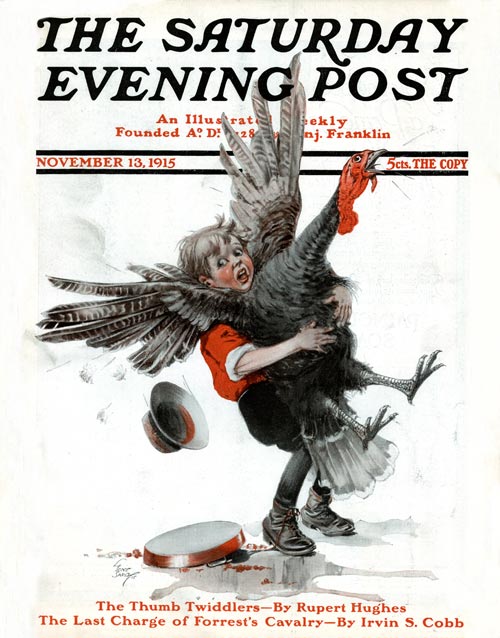
Tony Sarg
November 13, 1915
I’m trying to figure out how the scene in this cover by Tony Sarg unfolded. Why was a little kid sent to get a live turkey that’s even bigger than he is? What exactly is that on the ground, a pan and water?
“The Thumb Twiddlers” — mentioned below the picture — sounds like an article that could be written today about people addicted to smartphones and social media, but it’s actually a short story by writer and director Rupert Hughes, uncle of Howard.
Thanksgiving Recipes

Are you a traditionalist when it comes to Thanksgiving, or are you a bit daring? I’d like to think I’m the type of person who wants to try something new and out of the ordinary, maybe ham instead of turkey or Brussels sprouts or a pie made with a fruit I’ve never tried before. But when you get right down to it, I like my turkey and my mashed potatoes and the classic green bean casserole. Thank you, Dorcas Reilly!
But beyond those favorites, you’re going to need more for the day. Here’s a recipe for a sweet potato casserole, and here’s one for the perfect pie crust. Not sure how to cook your turkey? Here are some tips from McCormick, Food Network, and Melissa Clark at The New York Times.
If you have trouble cooking that turkey, you can always call the Butterball Turkey Talk-Line. They’ll tell you how long to cook your turkey, what to do if you bought your turkey in 1969, and what safety measures you should take for the stuffing.
Next Week’s Holidays and Events
World Hello Day (November 21)
This international holiday started in 1973, and the goal is for everyone on the planet to say “hello” to 10 people. And no, saying it to them on Facebook doesn’t count.
National Tie One On Day (November 22)
Macy’s Thanksgiving Day Parade (November 23)
While the turkey is cooking and the yams are yamming, you can turn the TV to NBC, where you’ll see the Macy’s Thanksgiving Day Parade, which NBC has televised every year since 1948. It starts at 9 a.m. Eastern.
Happy Thanksgiving!
News of the Week: Bad Weather, Pillsbury Dough, and the Rise and Fall of Stamp Collecting
October Surprise
Muggy today.
Muggy is not a word that should be used after Columbus Day. I’ll accept crisp, cool, and even apple-picking, but not muggy (or any of its sister words: humid, stifling, oppressive). This is October. Hockey season has begun. There are already Thanksgiving decorations at the supermarket. Shouldn’t we be wearing pants instead of shorts and drinking hot tea instead of iced?
I don’t know what the weather has been like where you are, but here in New England it feels like June or July. It has actually been rather depressing. Sure, I really dislike summer weather anyway (what many would consider “nice weather” I consider “bad weather”), but I sense that even people who live in flip-flops and love the beach are wondering when they can put their air conditioners away until next year.
Eat Love? Nay!
You can find a lot of things in granola: nuts, fruit, grains, brown sugar. But one thing you won’t find (and can’t eat) is “love.”
That’s the finding of the Food and Drug Administration in their case against the Nashoba Brook Bakery in Massachusetts, which for years has listed “love” as one of the ingredients on the granola they make and sell. Of course, the bakery wasn’t saying that there was an actual ingredient they put in the granola called “love.” It was more about the love and care they put into the making of their products. But the FDA says no, you can’t do that. They ruled that “a human emotion cannot be an ingredient in baked goods,” a line that has a sort of poetry about it.
This ruling has gotten a lot of attention, but what got a bit lost in the story is that the bakery has a few actual health code violations they have to deal with. But the company says they’ve already dealt with those problems.
Pillsbury Dough (Now with Less Dough)
There are changes afoot at The Pillsbury Bake-Off.
Since 1996, the company has given $1 million to the grand prize winner of the cooking contest (along with lesser amounts for other competitions within the contest). Before that, they gave $25,000. With the return of the contest this year — the most recent year for the contest was in 2014, with the winning recipe being Peanutty Pie Crust Clusters — Pillsbury is making several changes that might irk some longtime fans and participants.
First, they’re dropping the $1 million prize and going with $50,000. Now, that might seem like a lot less money, and it is, but the winner also gets a complete kitchen makeover from General Electric, an article in Food Network Magazine, and a guest appearance on Food Network’s The Kitchen. The total prize package is now around $92,000. I don’t know if cooks will find those things an adequate replacement for the million, but that’s the reality of the situation this time around.
Also, the contest is now completely online. You have until November 10 to get in your recipes for Cozy Breakfasts, Appetizers for Any Party, Dinners with Heart, and No-Fuss Desserts. Three winners will be named in each category, and the big winner from those winners.
Make sure you check the official rules to see if “love” is an acceptable ingredient.
Whatever Happened to Philately?
Stamp collecting has always seemed like a Herculean hobby to me. So many stamps, so many themes, how do you even know where to begin? But it’s also something I’ve always wanted to do.
This New York Times op-ed by a former stamp collector is rather sad. The author actually got rid of his stamp collection recently, even though he had an emotional attachment to it. With everyone paying bills online and stamps being produced in a cheaper way, he feels he’s being realistic about giving up his hobby.
But is being realistic even part of having a hobby? Even if people aren’t sending as many letters as they once did, does that make the collecting any less enjoyable or important? I would think that these factors would make stamp collecting even more enjoyable and necessary. Then again, as someone who still sends out letters, I have a soft spot in my heart for stamps and envelopes and the smell and feel printed matter.
I draw the line at quill pens though.
Overload
We are drowning in news and information. We have 24-hour news channels and social media, and it seems like a never-ending flow of information and words and pictures are streaming into our heads every single day. I used to laugh at people who needed “digital detox” days or breaks from technology, but I understand it completely. As this Guardian piece notes, our brains are being hijacked. I actually think that getting away from it all once in a while can give us a better perspective on the world when we come back to our computers and phones.
Ex-Face the Nation host Bob Schieffer has a new book out, Overload: Finding the Truth in Today’s Deluge of News, which delves into how all of the media and technology changes are not only affecting how news is reported but how we consume it. It could even be dangerous.
Schieffer interviewed 40 journalists for the book.
RIP Ralphie May, Bob Schiller, Y.A. Tittle, Mark Mooney, Nora Johnson, Elizabeth Baur, and Jack Good
Ralphie May was the big, beloved standup comic who came in second on the first Last Comic Standing on NBC in 2003. He died last Friday at the age of 45.
Bob Schiller was one half of a great comedy writing team with Bob Weiskopf. They wrote for I Love Lucy (including the famous “grape-stomping” episode and some of the episodes where the Ricardos and Mertzes visit Hollywood) and later for shows like All in the Family, Maude, and The Carol Burnett Show. Schiller died Tuesday at the age of 98.
Y.A. Tittle was a Hall of Fame quarterback who helped lead the New York Giants to three consecutive championship games and was seen in one of the iconic sports photographs of the 20th century. He died Sunday at the age of 90.
Mark Mooney was a veteran reporter who wrote one of the great goodbye columns in journalism history. He died last Friday at the age of 66.
Nora Johnson wrote the classic novel The World of Henry Orient, later made into a film starring Peter Sellers, along with other works. She died last Thursday at the age of 84.
Elizabeth Baur played Officer Fran Belding on Ironside and co-starred on the western Lancer. She also appeared in movies like The Boston Strangler and TV shows like Emergency! and Remington Steele. She died in late September at the age of 69.
Jack Good was an influential music and TV producer who changed how television presented rock and pop to British and American audiences with shows like Shindig!, Oh Boy!, and Six-Five Special. He died in September at the age of 86.
This Week in History
The Great Chicago Fire (October 8–10, 1871)
The classic story is that a cow owned by a Mrs. O’Leary started the fire that destroyed much of the city, killed as many as 300, and left a third of the citizens homeless by knocking over a lamp, but there’s always been some skepticism about that. It might have been caused by gamblers knocking over a lantern or simply related to other fires that were happening in the area at the time.
Eleanor Roosevelt Born (October 11, 1884)
Did the former First Lady write for the Post? She did! Roosevelt wrote a five-part series in 1958 in which she gave her opinion of several people, including Winston Churchill, Richard Nixon, and John F. Kennedy. Five years earlier, she appeared as the mystery guest on What’s My Line?
This Week in Saturday Evening Post History: Flirting Soda Jerk (October 11, 1947)
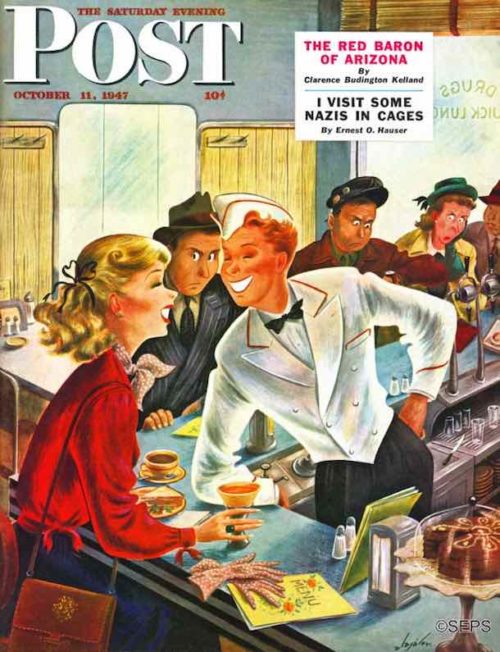
Constantin Alajalov
October 11,1947
I was looking at these pictures of beautiful soda fountains that I’d love to visit (road trip anyone?) and wondering, do soda jerks still exist? They do, of course, though I wonder if teens today would like being called “jerks” in any context. I love this cover by Constantin Alajálov. It’s very 1940s, with its sharp lines and big grins and all the men in hats, irritated that the guy in the paper hat is paying more attention to the cute girl at the counter instead of refilling their coffees.
National Yorkshire Pudding Day
Like a lot of people, I used to think that Yorkshire Pudding was, well, pudding. English pudding, but pudding nonetheless, a chocolate, gooey concoction you ate with a spoon. But I found out a few years ago that it’s actually a type of popover. Okay, so I’m not completely up to speed on my food knowledge.
Today is National Yorkshire Pudding Day, so here’s a recipe for a classic version and here’s a recipe for what we call Anytime Popovers.
Today is also Friday the 13th. That has nothing to do with Yorkshire Pudding, but it seems odd not to mention it.
Next Week’s Holidays and Events
Dictionary Day (October 16)
When I was a kid, I used to read the dictionary. Not just once in a great while when I needed the definition or correct spelling of a word; I read it all the time, for pleasure, like kids read Harry Potter. There’s something fascinating about words, their origins, and their meanings. I even love how a dictionary is formatted, and even though we now live in a world when dictionaries are just a few clicks away, a big old Webster’s or Oxford or American Heritage are still something we should all own.
Boss’s Day (October 16)
This holiday was started by Patricia Bays Haroski in 1958. Some people don’t think much of the day, but I’d like to take this opportunity to say that my boss is the nicest, kindest, best-looking person on the planet.
News of the Week: Hello Autumn, Goodbye Cassini, and Yes, Virginia, There Is Cheese Tea
Fall Begins
I was trying to find a poem about fall that I could mention here, but most of the poems I found are rather depressing. They talk about the sadness of the light of summer dying, or how the leaves are changing and it’s a bad thing, or how autumn is just a precursor to winter, which we all know is the worst season of all. But I actually love fall — and winter for that matter — so I didn’t include one.
Today is the first day of fall, and I’m glad that summer is over. I’m ready to replace my iced tea with hot, my shorts with jeans, my T-shirts with sweaters, and my screen door with glass. I’m also looking forward to fall because maybe, just maybe, the cold weather will drive away the people who hang out at the base of my stairs, leaving their coffee cups and other refuse.
The Cassini Crash
We told you back in May about the stunning pictures the spacecraft Cassini was sending back from Saturn. No more pictures will be coming from Cassini, as this week it crashed onto the surface of Saturn.
But don’t be sad! The spacecraft spent a successful 20 years sending back photos and other data from Saturn and its many moons. Cassini took one last photo before crashing just north of Saturn’s equator.
Sitting Is the New Smoking
If you’re sitting there reading this… stand up!
Suddenly, sitting down is incredibly bad for you. Based on a recent study and many past studies, doctors are actually saying that sitting is the new smoking. The longer middle-aged and older people sit, the more likely they are to have problems with obesity, diabetes, and heart disease. Of course, like most studies, the data is incomplete and might not tell the whole story. But it wouldn’t hurt to get up from your desk to walk and stretch once in a while.
This sounds like one of those health things that, well, isn’t that easy to fix. Sure, we can walk around more and make sure we exercise in general, but sitting is what we do, at home and at work. It’s like telling someone that standing is really bad for you and you should sit more. Yeah, okay, but it’s hard to go places if you can’t stand up. If sitting is bad for us, how dangerous is lying down and sleeping eight hours a night?
I was wondering why I’ve been seeing so many commercials for those standing desks and treadmill desks.
The Happiest State Is …
A question for all of our readers in Minnesota: Are you happy?
You should be, because your state came in first in a study conducted by WalletHub. The site takes data and ranks the states in categories like Emotional and Physical Well-Being, Work Environment, and Community and Environment. Minnesota was number one, followed by Utah and Hawaii. Sorry, West Virginia, but you came in dead last. Sad!
Of course, I don’t know how accurate this study is, so I wouldn’t recommend you suddenly get depressed just because you live in a state that’s low on the list. I mean, I don’t feel like I live in the 19th-happiest state. It feels more like top 10. Certainly top 15.
Cheese Tea Is a Thing, Apparently
Some food combos make a lot of sense. There’s peanut butter and milk chocolate, bagels and cream cheese, and of course peanut butter and jelly. But how did anyone think of putting cheese in their tea?
The Daily Mail says it’s an Asian trend that is coming to New York and Los Angeles. It’s the popular bubble tea, hot or cold, only topped with a sort of whipped cream cheese. This is becoming one of those trends that you are about to hear a lot about but will probably never actually experience yourself, like planking or winning the lottery.
I’m addicted to tea — it’s 11 a.m. and I’m already on my third cup — but this is something I just have no interest in trying. I mean, I’m not even a big fan of teas flavored with fruit, so I’m not going to top my tea with the same stuff I top my nachos with.
I like chocolate chip ice cream and I like onions, but I’m not going to combine them.
The Man Who Carved Mount Rushmore
This week, the National Park Service finally recognized the work of Italian immigrant Luigi Del Bianco, the chief carver of Mount Rushmore. Here’s a report from Jim Axelrod of CBS Sunday Morning.
RIP Harry Dean Stanton, Jake Lamotta, Frank Vincent, Lillian Ross, Grant Hart, Stanislav Petrov, J.P. Donleavy, Mike Hodge, Bobby “The Brain” Heenan, and Mark Lamura
Harry Dean Stanton was one of the great character actors, appearing in so many movies and TV shows that you’ll have to take a few minutes to read his IMDb page. He has the lead in the new movie Lucky and was recently seen in Twin Peaks: The Return. He died last Friday at the age of 91.
In 2013, Lawrence Grobel interviewed Stanton for the Post.
Jake Lamotta was the brawling boxer who inspired the classic Martin Scorsese film Raging Bull. He died earlier this week at the age of 95.
Frank Vincent was an actor who appeared in Raging Bull but is probably best known for his role as Phil Leotardo on The Sopranos. He also appeared in such classic films as Goodfellas and Casino. In the 1970s, he was in a band with fellow actor Joe Pesci. Vincent passed away last Wednesday at the age of 80.
Lillian Ross was an acclaimed writer and journalist who, except for a short break in 1987, worked at The New Yorker from 1945 until 2012. She authored several books, including Here but Not Here and the 2015 collection Reporting Always. She died Wednesday at the age of 99.
Grant Hart was the drummer and one of the lead singers of the rock group Hüsker Dü. He died last week at the age of 56.
Stanislav Petrov saved the world in 1983 when, while working as a military officer at a Russian nuclear early-warning center, he got information saying that the United States had launched several nuclear missiles. He decided to check things out instead of retaliating, and it turns out it was a false alarm. Petrov died in May at the age of 77.
J.P. Donleavy was an author known for several novels, including The Ginger Man. He died on September 11 at the age of 91.
Mike Hodge was an actor who appeared in many TV shows and movies. He was also the New York local president of the Screen Actors Guild-AFTRA. He died Saturday at the age of 70.
Wrestling fans will remember Bobby “The Brain” Heenan. He was the colorful manager of such wrestlers as Andre the Giant, Rick Rude, and King Kong Bundy. He died Sunday at the age of 72.
Mark Lamura was an actor known for his many years playing Mark Dalton on All My Children. He also appeared in several other shows, including The Sopranos, 30 Rock, and Star Trek: The Next Generation. He died last week at the age of 68.
This Week in History
Earthquakes Hit Mexico City (September 19, 1985)
The earthquake that hit Mexico City on Tuesday came on the anniversary of the first of two earthquakes that hit the area 32 years ago, which killed thousands and caused billions of dollars worth of damage. The second earthquake hit a day later.
“Yes Virginia, There Is a Santa Claus” Editorial (September 21, 1897)
Don’t worry, you haven’t fallen asleep for three months. It’s still September and way too early to talk about Christmas. But the answer to the famous letter from 8-year-old Virginia O’Hanlon was published in The New York Sun this week in 1897. Some interesting trivia: O’Hanlon was the cousin of George O’Hanlon, the actor who did the voice of this guy.
This Week in Saturday Evening Post History: Norman Rockwell’s Runaway (September 20, 1958)
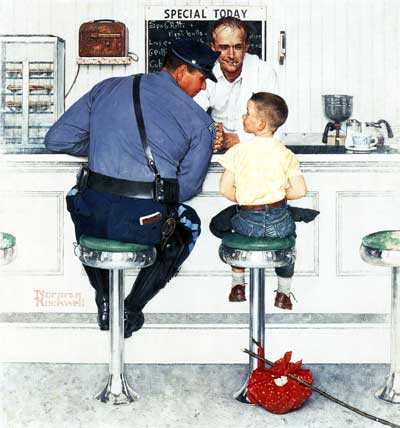
I think we can all agree that this cover is the most famous Norman Rockwell work, right? Well, it’s certainly up there with Freedom from Want. Here’s a 2011 interview with the Massachusetts state trooper and little boy who posed for the painting, Dick Clemens and Ed Locke (Clemens passed away in 2012):
Get Ready for the Return of Pumpkin-Spiced… Everything
The start of the fall season means it’s the start of pumpkin spice season. If you haven’t noticed, everything is pumpkin-spiced now. Not just the drinks at Starbucks, but also cereal, butter, pizza, and, of course, dog cologne. We were promised jet packs and flying cars but instead we got Facebook and pumpkin-spiced everything.
A lot of people hate pumpkin spice and dread all of the products that include it. As someone who actually likes the flavor (within reason), I really don’t mind the onslaught of pumpkin-spice-flavored drinks and cookies and cakes. A thousand recipes caught my eye, but I’d go with these Pumpkin Chocolate Chip Squares from Recipe Girl.
By the way, I just checked my high blood pressure medication, and guess what? Pumpkin spice flavored.
Next Week’s Holidays and Events
Oktoberfest (September 23–October 8)
This is billed as the world’s biggest fair, but we all know that when you hear the word Oktoberfest, you think of beer.
National Good Neighbor Day (September 28)
Do people still borrow cups of sugar from their neighbors? I was thinking of that before coming across this day started by Lakeside, Montana, resident Becky Mattson in the 1970s. Why do people always run out of sugar and not eggs or milk or bread? Will people some day borrow pumpkin spice?
Leading Men of Hollywood: Kirk Douglas
This is an abridged version of two articles written by Kirk Douglas with Pete Martin, which appeared in the in the June 22 and June 29, 1957, issues of The Saturday Evening Post. You can read the complete original article in the flipbook, below.
This article and other features about the stars of Tinseltown can be found in the Post’s Special Collector’s Edition, The Golden Age of Hollywood. This edition can be ordered here.
Apparently the public takes it for granted that if you’re a successful actor, you must be a schmoe. There’s nothing like scoring a hit to make people hunt for new, unpleasant traits in your character. Searching for them, they discover them whether they’re there or not. Then they say, “What did I tell you? He’s changed.”
Usually the change is in other people, not the actor. As a raw newcomer to Hollywood, I had trouble getting a table in the swankier local restaurants. Now I can get a table most of the time, although I don’t deserve it any more than I did 10 years ago. What has changed is not me but the attitude of the headwaiters toward me.
The first movie in which I made a splash was Champion. After I appeared in it, I was told by a woman columnist, “You’ve changed. Now you’re sexy.”
A writer told me: “Making a hit in Champion changed your personality. I don’t like you now.”
“I haven’t changed,” I told him. “I was an s.o.b. before I did Champion and I’m still an s.o.b., only I was too unimportant for you to notice it before.”
I think that I’m still the way I was before Champion. I didn’t kowtow to producers then; I’m not noted for it now. Even when I was a bum, standing in line on the Bowery to buy a cheap Salvation Army meal, I didn’t buddy up to people I thought were jerks, no matter how much good they could do me. This is not always the accepted way to get ahead. Too often in the entertainment field, the idea persists that you can ignore influential creeps only after you have become successful.
Nowadays when I go back to my hometown, Amsterdam, New York, everybody there takes it for granted that I must have an ego the size of a weather balloon. People in Amsterdam ask me, “Do you remember when we did so-and-so?” and when I say, “Sure, I remember,” they’re amazed.
“What do you know!” they exclaim. “Kirk remembers.”
I want to ask them, “If you remember little things that happened around you. How many people are doing what they want to do? Yet no one ever hit an actor over the head to make him become an actor. You’re an actor because that’s what you want to be, despite all the difficulties.
An actor’s need to project his emotions from his insides to his outside sandpapers his nerves. His feelings lie so close to the surface that such terms as “crazy” and “mixed up” are often applied to him.
My friend, producer-director Billy Wilder, gives me the berry for hankering to play every good role Hollywood offers. He says, “Kirk gives you all he’s got. His chest begins to heave even before a director snaps his fingers. He doesn’t need violins playing in a corner to put him in the right mood.” I hope he’s right. If he means that I enjoy acting, he is right.
There’s another thing about actors — every one of them wants to play each role he’s given better than it’s humanly possible for him to play it. I not only want to achieve perfection in each role I play, I want to play all the good roles there are to play. It’s absurd to feel this way, but it makes me unhappy that I can’t be starring in my next picture, The Viking, and playing two other top roles at the same time.
I’ll always believe that there’s value in being willing to work like a horse to do a better job. Until I played the prize fighter in Champion, I had never boxed at all. When I started work in Champion, I had three left hands, none of which could jab or throw a punch, but I trained in a gym until I became a passable fighter.
It could be that my willingness to work long and hard to master a new skill is just another manifestation of my desire to create a sensation with an unexpected accomplishment; then throw it away by saying, “It’s really nothing.” But I honestly don’t think that’s it. It’s not so much exhibitionism on my part as a need to believe in those games of “Let’s pretend.” If I believe in them hard enough, moviegoers may believe in them too.
The Truth
I’m the kind of actor I am because in a few small, important ways I am still the boy named Issur Danielovitch who lived near the carpet mills in Amsterdam, New York. If an actor lets himself become blasé, he can’t play the game of let’s pretend, which is the essence of being an actor. He’s lost if he says to himself, “What am I doing here, a grown man, pretending I’m a cowboy? This is ridiculous.”
If you can’t pretend without being self-conscious, if you begin to think, Get me, everybody. I’m an actor, and I’m acting the pants off of this role. You’ll end up by thinking of yourself as a star with a capital S, and you will be a flop with a capital F.
Perhaps I’ve dwelt too long on the odd traits of actors; they have virtues too. The most generous people I’ve ever dealt with are actors and newspapermen. Pass the hat for a needy co-worker in either group and you’d better have a big hat. And no one is willing to work harder than an actor—to the end of his endurance, if need be. This goes for any actor, famous or obscure.
My agent once said of me, “Kirk is always riding me to put out more effort on his behalf. I spend more time on him than I do on any other two stars on my list, so in a way he’s more trouble to me than he’s worth. But it’s only fair to say that the guy drives himself harder than he drives me. ‘Hey, Douglas,’ he tells himself. ‘Do something. Get going! Get off the dime!’”
Whatever drive I have stems from lessons learned a long time ago. When I was working my way through St. Lawrence University, I once lost my small fund of cash in a poker game. Much ashamed, I had to go home to my hard-pressed mother and tell her.
“You are such a fool,” she chided me. “You bet money on cards. What do the cards know about you? What do they care?” She gave me a hug and said, “Everyone likes to gamble. There’s nothing wrong with gambling. You want to bet? O.K., bet. But gamble on yourself.”
I have found that the perfect place to take her advice is in acting. I’ve never hesitated to gamble for really big stakes—abandoning my contract at Warner’s, starting my own independent company, Bryna Productions. I’ve been lucky enough to make a few good pictures, but I don’t assume that I’ll never boot one. No one bats a thousand in any league, and a champ is a guy who walks into the ring one day and gets clobbered by a kid no one ever heard of. All I can do is work as hard as I know how, and, when the chips are down, gamble on myself.
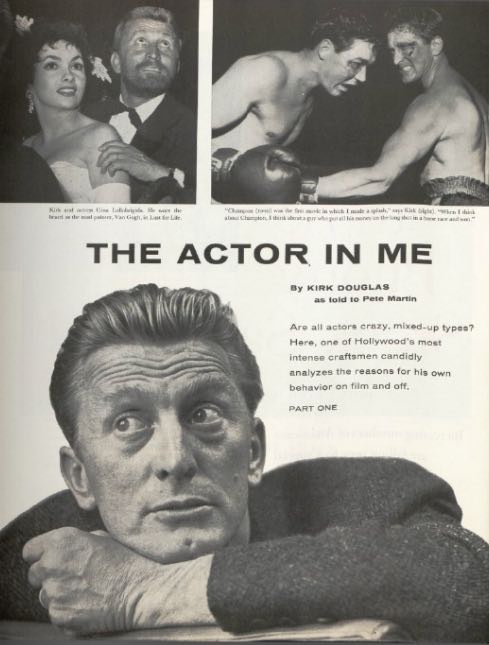
This article and other features about the stars of Tinseltown can be found in the Post’s Special Collector’s Edition, The Golden Age of Hollywood. This edition can be ordered here.
America’s First Subway
Just four years after the Civil War, New York began constructing the first subway in America. It opened in February 1870 but never became more than a block-long prototype of a pneumatic-powered system.
At the time, engineering “experts” warned investors away from the subway system. It would be crushed, they said, by the weight of those enormous buildings overhead, like the five-story-tall Astor House hotel!
So the honors for the first operating subway went to Boston, which opened its 1.5-mile long underground system on September 1, 1897. It marked the beginning of an underground movement as cities began burying parts of their infrastructure.
New York finally launched its own subway system in 1904, and it soon became the world’s largest.
By 1936, it had become part of New York’s many subterranean systems that fascinated Post writer Milton MacKaye.
In “Underground Empire,” which the Post published on month, date, 1936, MacKaye describes the system that handled 1.6 billion fares every year and supervised 1,100 miles of subway track. Underground travel had become such an essential part of life that subway stations featured stores, hotels, restaurants, movie theaters, and night clubs.
With Manhattan so crowded, it made sense for the city to bury its rapid transit, as well as its utilities. Beneath the sidewalks, as MacKaye writes, lay thousands of miles of gas and water mains; steam and sewer pipes; power, telephone, and telegraph lines; and the wiring for police and fire-alarm systems.
He also reported that New York had a 28-mile pneumatic-tube system that pushed 28-pound mail-filled torpedoes across the city to 23 post offices.
Today, New York’s subway is as vital to the city as it was in 1936. Its 1,500 miles of track connect 472 stations, helping to deliver over 5 million passengers to their destinations every day. And much of its old pipes and wiring are still in service. But the pneumatic mail system that fascinated MacKaye is no more. It was shut down in 1953.
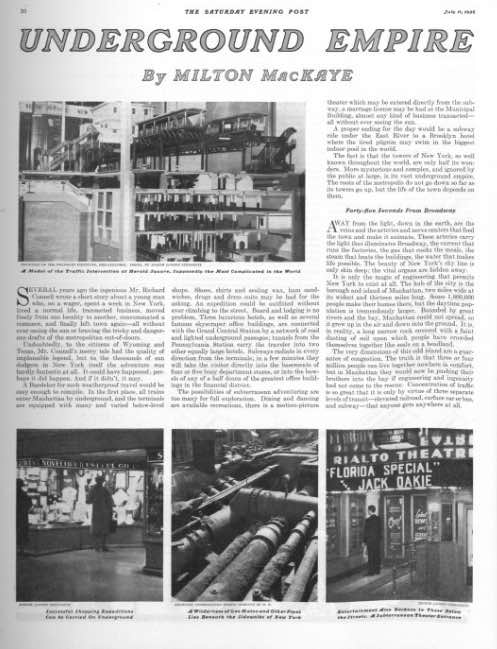
Featured image: 59th Street Circle, 1901 (New York Public Library)
News of the Week: Buttered Rolls, Marilyn Monroe, and Rockwell at the Swimming Hole
Only in New York?
Another week, another controversy that breaks the internet. Sometimes you can see them coming, like that Google manifesto that has the left and the right taking sides, or weird/funny videos that go viral. But sometimes something takes over the web that you could never predict, like that dress a couple of years ago that no one knew the color of (I knew it was black and blue!) Yes, there was a day when everyone online was arguing about the color of a dress.
Now we have a new controversy: buttered rolls!
This New York Times piece by Sadie Stein extols the virtues of the buttered roll, which she and many other people say is a thing unique to New York City. Now, you might have the same first reaction that I and many other people online had: Can’t you get buttered rolls, well, everywhere?
Apparently not! Not like the ones in New York! To be fair, it seems like Stein’s talking about a certain type of roll (a big hard roll with butter in the middle, almost like a butter sandwich) that you get in certain places, like bodegas and carts and delis, and you eat it for breakfast with your morning coffee. I’ve never had one of these, but they still seem like, you know, a roll with butter. I’ve had a lot of those.
This paragraph stands out:
Though of course bread and butter are eaten all over, the buttered roll (or roll with butter, as it is known in parts of New Jersey) is a distinctly local phenomenon. Mention its name outside the New York metropolitan area and you would very likely be met with blank incomprehension.
I very much doubt that, even if our buttered rolls aren’t “buttered rolls.” But what do I know? The article has a lot of defenders, including Stein’s New York Times cohort Pete Wells, and detractors, like BuzzFeed’s Tom Gara. Stein knew there would be people who didn’t understand:
In response to inevitable carping…yes, NYers are incurable solipsists. AND the specific buttered roll discussed here is a specific thing.
— Sadie Stein (@SadieStein) August 2, 2017
David Letterman Is Back!
I knew he wouldn’t stay away. As soon as I heard him talking about how he wished he had thought of Comedians In Cars Getting Coffee and noticed that he had started to do more interviews and podcasts, I knew he would be the anti–Johnny Carson and actually come out of retirement to do another show. Letterman just signed with Netflix to do six episodes of a new talk show starting in 2018. Instead of many guests, Letterman will sit down with one guest for the entire show. I’m thinking it’s going to be more Charlie Rose, less The Late Show.
But Dave, please, shave off that beard.
Speaking of Netflix…
Pop quiz: Who’s going to play Lucille Ball in a new biopic Aaron Sorkin (The West Wing, The Social Network, A Few Good Men) is writing for the streaming service?
- Cate Blanchett
- Meryl Streep
- Debra Messing
- Tea Leoni
- Amy Adams
Here’s the answer. Now we can all make our predictions on who should play Desi Arnaz.
Does America Have a Tattoo Problem?
I was watching an episode of The Dick Van Dyke Show a while back. Sally was telling Rob and Buddy that she would date a guy who had a mustache even though she never liked them before. She then said the next thing she was going to be into was tattoos, which shows how rare it was for men to have them back then (unless you were in the military).
How times have changed. You can’t leave the house without seeing at least one man (or woman) who has at least one tattoo. This piece at The Federalist argues that America has a tattoo problem.
I’ve never been tempted to get a tattoo. I did think about getting my ear pierced for about five minutes back in the ’80s. I’d have to get a really subtle tattoo, small and in a place no one could see it, because, well, they can get out of hand.
A Modern-Day Norman Rockwell Painting
This is proof that Twitter isn’t completely annoying: a photo taken at a recent Boston Red Sox game at Fenway Park that could pass, as Maury Brown says, as a Rockwell:
This is an absolute modern day Norman Rockwell painting. pic.twitter.com/SxYF6JRkof
— Maury Brown (@BizballMaury) August 4, 2017
RIP Glen Campbell, Barbara Cook, Robert Hardy, Don Baylor, Darren Daulton, Daniel Licht, Ty Hardin, Haruo Nakajima
Glen Campbell not only performed such classic songs as “Wichita Lineman,” “Rhinestone Cowboy,” and “Gentle on My Mind,” he was also a member of the famous group of session musicians known as The Wrecking Crew and played guitar on many other songs, including The Beach Boys’ “I Get Around” and “Help Me, Rhonda,” Ricky Nelson’s “Hello, Mary Lou,” Wayne Newton’s “Danke Schoen,” and Frank Sinatra’s “Strangers in the Night.” He died Tuesday after a battle with Alzheimer’s Disease. He was 81.
Barbara Cook was the Broadway soprano who won a Tony for The Music Man and appeared in other classic musicals like Candide and She Loves Me. She passed away Tuesday at the age of 89.
Robert Hardy was a veteran actor who played Cornelius Fudge in the Harry Potter movies and appeared in many other movies and TV shows, including several in which he portrayed Winston Churchill. He died last Thursday at the age of 91.
Don Baylor and Darren Daulton were two baseball favorites who passed away this week. Baylor was not only the 1979 MVP, he led the league in getting hit by pitches: seven times in his career. He died Monday at the age of 68. Daulton was an All-Star catcher for the Philadelphia Phillies. He died Sunday at the age of 55.
Daniel Licht did the music for Dexter and many other TV shows and films. He died last Wednesday at the age of 60.
Ty Hardin played Bronco Layne on the 1958–62 CBS Western Bronco and also appeared in movies like PT 109, The Chapman Report, and Merrill’s Marauders. He died last Thursday at the age of 87.
You wouldn’t recognize Haruo Nakajima because his face was usually hidden inside a suit. The Godzilla suit, to be exact. He was the first person to put it on and stomp around Japan in 1954 and played the monster in 11 more films. Nakajima died Monday at the age of 88.
This Week in History
Marilyn Monroe Dies (August 5, 1962)
The last professional photos of Marilyn Monroe, taken by George Barris three weeks before her death, went up for auction this week. The auction ends at 12:07 p.m ET today, so get your bid in quick.
President Nixon Resigns (August 9, 1974)
Nixon was really excited about taping his Oval Office meetings for posterity, but the practice eventually led to this:
This Week in Saturday Evening Post History: “Swimming Hole” (August 11, 1945)
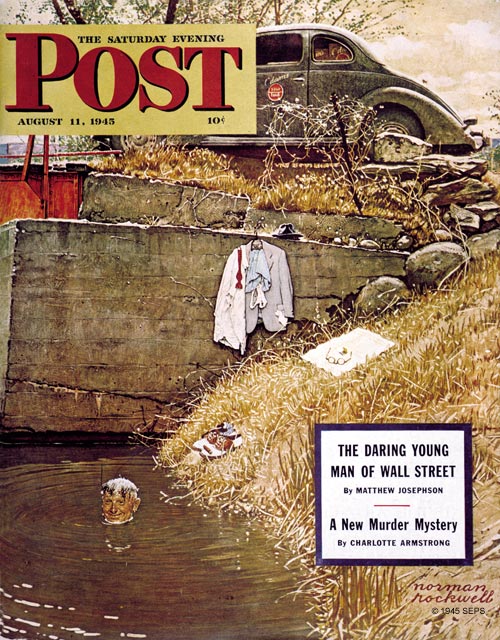
Norman Rockwell
August 11, 1945
© SEPS 1945
Here’s an actual Norman Rockwell cover, one where he shows a salesman taking an impromptu dip on a hot summer day. I’m trying to find his pants, though. I see his shirt, jacket, tie, shoes, and even glasses, but I can’t find the pants.
Paninis
August is National Panini Month. Food Network has 50 panini recipes you can try, which means you can have two every day for the rest of the month without repeating a recipe. If you don’t own a panini press, you’ll have to use a heavy pan to press it down in the skillet.
If a panini is too much work for you, you could just make a regular, old-fashioned sandwich, because it also happens to be National Sandwich Month. You could even have a sandwich on a roll.
You know, with butter.
Next Week’s Holidays and Events
International Left Hander’s Day (August 13)
If you’re right-handed and have always looked at left-handers as “different,” Sunday’s the day you can treat them as if they were normal.
National Roller Coaster Day (August 16)
I’m not a roller coaster fan. I’ve been on one, years ago at Canobie Lake Park in New Hampshire, and I’ll never go on one again. But National Roller Coaster Day is the day to get on one and ride it again and again and again.
News of the Week: McEnroe’s Comments, Martha the Dog, and the Man Who Predicted Selfies
Serena Williams vs. John McEnroe
John McEnroe is known for saying things. He used to be known for yelling things, but he’s quieter now, though probably no less opinionated.
During an interview with NPR about his new memoir, But Seriously, the 7-time Grand Slam Singles winner said that if 23-time Grand Slam Singles winner Serena Williams played with male tennis players, she probably wouldn’t be in the top 700. Of course, this is the part of the interview that everyone has latched onto — which is probably good for book sales — and it got a reaction from Serena herself on Twitter (where everyone releases official statements now, apparently).
Dear John, I adore and respect you but please please keep me out of your statements that are not factually based.
— Serena Williams (@serenawilliams) June 26, 2017
I've never played anyone ranked "there" nor do I have time. Respect me and my privacy as I'm trying to have a baby. Good day sir
— Serena Williams (@serenawilliams) June 26, 2017
Serena gets points for using the phrase “Good day, sir.” We need to use that more.
Now, to be fair to McEnroe, it’s not like he brought this up out of the blue to insult Serena. He simply said during the interview that Serena Williams was the best female tennis player of all-time (in fact, he has said that Serena is one of the best athletes in history, period), and the interviewer asked him why he had to say “female” and not just “best” including men. What an odd thing to ask. Men and women are different (I realized this the first time I went to the beach) and that also extends to professional sports, too. Why can’t we talk about how good or bad an athlete is by separating them into different categories when the very sports themselves separate them?
Even Serena (and it’s funny how we simply call her by her first name, that’s how iconic she is) said during an interview with David Letterman that she couldn’t beat a man, someone like Andy Murray, because the women’s game is different than the men’s game. Men are stronger and faster. So I don’t think we can say that McEnroe is “wrong,” and he certainly wasn’t being misogynistic.
I do take issue with the number 700 though. She wouldn’t have a chance against someone ranked so low that nobody knows who he is? With her serve and mental strength, I bet she’d be in the match.
And the World’s Ugliest Dog Is …
There seems to be two types of dogs that compete in the World’s Ugliest Dog contest in Petaluma, California, every year. They’re either big and slobbering or goofy or small and, well, rat-like. This year’s winner is Martha, a 3-year-old Neapolitan Mastiff that weighs 125 pounds and clearly falls into the former category.
Come on, she’s not really ugly, she’s just … droopy.
RIP Gabe Pressman, Michael Bond, and Michael Nyqvist
Gabe Pressman was a legend of New York news, starting out his six-decade career at several newspapers, including the Newark Evening Sun and New York World Telegram and Sun before moving on to a long TV career at WNBC in New York. Except for eight years in the 1970s where he worked for WNEW, he was with WNBC from 1956 until his death. The Emmy-winning journalist died last Friday at the age of 93.
Michael Bond was the author who created Paddington Bear. He also was the author of a series of novels featuring Detective Monsieuer Pamplemousse. Bond died earlier this week at the age of 91.
Michael Nyqvist was so good at playing the bad guy, in movies like Mission: Impossible — Ghost Protocol and John Wick. He also played the lead in the Swedish Girl with the Dragon Tattoo movies and appeared in a cool sci-fi ABC show a few years ago, Zero Hour, that really should have lasted longer. He died Tuesday at the age of 56.
World Asteroid Day

It’s funny how we go about our lives and hardly ever think about what’s going on in the skies above us. I don’t want to alarm anyone, but there’s a chance an asteroid could hit us.
Today is World Asteroid Day, which is a good day for scientists and world leaders to think about doing something about the problem. NASA actually has a Planetary Defense Coordination Office, which sounds like an organization from a sci-fi movie. Last December a NASA scientist warned that the world really isn’t 100 percent ready for an asteroid or comet hitting our planet, though we are getting better at it. It’s probably best not to think about it.
In related news, CBS’s Salvation, a new summer series about a group of scientists who band together to stop an asteroid from hitting the earth, premieres on July 12. Perhaps you’ve seen one of the 50,000 commercials for it that the network has been running every day for the past two months?
People Really Dig Salvador Dali
It doesn’t seem fair to have no control of your body after you die. There you are, in the ground resting, your life on Earth over and done with, and all of a sudden people are digging you up and bringing your body back to the surface so they can examine it.
That’s what’s happening to surrealist artist Salvador Dali, whose body is going to be exhumed by order of a Spanish judge to settle a paternity suit brought by a woman who claims to be his daughter. The woman says that Dali had an affair with her mother, who worked as a nanny near Dali’s home.
Dali’s estate is worth hundreds of millions of dollars, but the woman says it isn’t about the money, it’s about finding out who she is and revealing the truth for her mother.
The Best Game Shows of All-Time
Well, look at this: an internet list that isn’t terrible.
Newsday has picked the 25 best game show of all-time, and it’s really a well-balanced list. Yes, I could argue — and I will argue — that shows like Love Connection, Deal or No Deal, and The Dating Game don’t deserve to be on any kind of best game show list, I’m impressed that most of the list is taken up by truly great, classic shows like The Price Is Right, To Tell The Truth, Password, The $64,000 Question, Jeopardy, Wheel of Fortune, and What’s My Line?
To replace the shows that shouldn’t be on the list I’d probably add Remote Control, Tic Tac Dough, Truth or Consequences, Scrabble, maybe Blockbusters, and how about Battle of the Network Stars, which came back to ABC last night?
We need more game shows on television. Just get rid of talk shows like The View and celebrity shows like Access Hollywood and they’ll be plenty of room.
Charles Schulz Predicted Selfies
The frequent Saturday Evening Post contributor was ahead of his time in many ways, including when it comes to picture-taking.
📷📷📷 pic.twitter.com/rn1HC6LFBa
— Charlie Brown Fan Account (@Peanuts_4Fans) June 25, 2017
This Week in History: Jack Dempsey Born (June 24, 1895)
The world heavyweight champion boxer actually wrote an article for the August 29, 1931, issue of The Saturday Evening Post, on what happened behind the scenes before his losing battle with Gene Tunney.
This Week in History: Korean War Begins (June 25, 1950)
This Week in Saturday Evening Post History: “Peachtree Street” by John Falter (June 25, 1960)
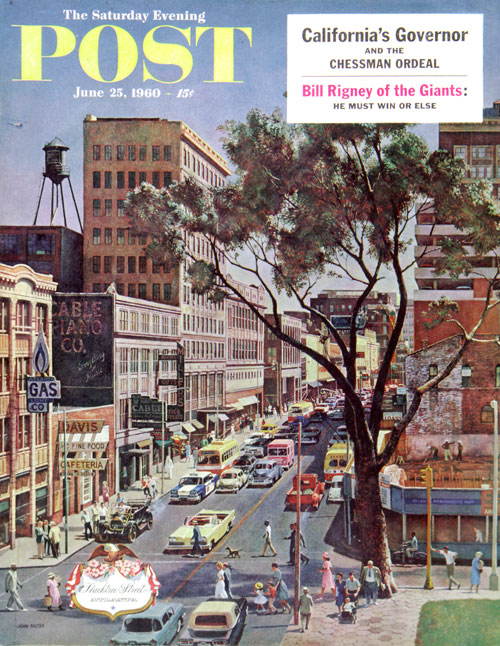
John Falter
June 25, 1960
If I wasn’t a writer I’d want to be an artist or cartoonist, but I don’t have the skill for it. Even my stick figures look kinda funny. I mean, I can’t even begin to understand how John Falter created the way that he created, the mix of color and shadow, the way he gets the perspective right. There’s so much going on in this picture, so many places to look and explore, that it’s rather mesmerizing.
July Is National Ice Cream Month

With that Falter cover you know that I have to link to a recipe for peach ice cream, right? It’s from Southern Living and it’s officially called Summertime Peach Ice Cream. It looks easy to make too, just evaporated milk, condensed milk, half and half, sugar, and vanilla instant pudding mix.
Oh, and peaches. Don’t forget the peaches.
Next Week’s Holidays and Events
International Joke Day (July 1)
Here’s my favorite joke:
Knock-knock
Who’s there?
Interrupting cow.
Interrupting co …
MOOOOOOOOO
Wimbledon Begins (July 3)
Because she’s pregnant, Serena won’t be able to play the 700th man in the world or anyone else, but McEnroe will be one of the commentators when the tennis tournament kicks off on Monday, a week later than usual. You can watch the action live on ESPN (and on tape on Tennis Channel at night).
Independence Day (July 4)
In between the eating of burgers and the watching of fireworks, take a look at this collection of classic Saturday Evening Post covers that celebrate the day.
Was the Pop Music of the 1960s the Most? Or Just a Mess?
[Editor’s note: Alfred G. Aronowitz’s “Pop Music: The Most? Or Just a Mess?” was first published in the July 15, 1967, edition of the Post. We republish it here as part of our 50th anniversary commemoration of the Summer of Love. Scroll to the bottom to see this story as it appeared in the magazine.]
Eight stories over Hollywood’s Sunset Strip and 6,000 miles from his native Liverpool, press agent Derek Taylor looked out his window and muttered that it was the 20th of the month and none of his accounts in the pop-music business had paid him yet. It was the beginning of 1967, and the pop-music world that Taylor had felt so conveniently at his fingertips suddenly seemed to be moving beyond his grasp. In London, there were rumors that the Beatles would never perform again in public. In New York, Herman was said to be looking for a TV job — without his Hermits. The Young Rascals, once heralded as the American group most likely to succeed the Beatles, had just returned from a European tour that lost $22,000. Mod shops were thinking about stocking cowboy shirts. Groupies were torn between reading Hermann Hesse’s mystical Siddhartha and the monosyllabic teenybopper bible, 16 Magazine.
Outside Taylor’s window, the afternoon glowed the way Marilyn Monroe’s hair did when she rode down the Sunset Strip in a convertible. In a couple of hours, the glow would vanish, and the Strip would become a battleground, the cops versus the mini-masses, long-haired, bell-bottomed teenagers who have become the shock troops of Hollywood’s psychedelic revolution. Once upon a time Derek Taylor was the press officer for one group, the Beatles, but now he was the publicity man for a dozen Top 40 recording stars. He knew the pop-music world as well as anyone, but still confessed his bewilderment. “The industry,” he said, “is booming. It should do a billion dollars this year. But it is not in good shape.”
By the middle of 1967, America’s pop-music scene has become as incomprehensible to the people who dreamed it all up as it is to the people who are sleeping through it. A new generation of music critics is hard at work trying to institutionalize the confusion by grinding out such vague descriptive labels as acid rock, raga rock, jug rock, Broadway rock, Latin rock, shock rock, and rock ’n’ wreck. They also have come up with old time, good time, soul, blue-eyed soul, psychedelic surf, and flower power. It is as if some magician had started pulling tricks out of a hat and found, to his amazement, that the hat contained more surprises than his magic could account for. Composers and performers are blending baroque fugues with science-fiction tape-recorder sounds. Teenage analysts are writing long treatises about the difference between the metallic sound of the Rolling Stones and the kinetic sound of the Four Tops. An English group called the Who is smashing its instruments into hemidemisemisplinters as a regular part of its act. The Beach Boys have spent an astonishing 90 hours in a recording studio to grind out one 45-rpm single. A pop audience that once cheered the extraordinary Beatles is now rooting for the ordinary Monkees. Herb Alpert and the Tijuana Brass have become the Lawrence Welk of the Acid Age. And San Francisco has proclaimed itself the new Liverpool.
With the sale of single records dropping significantly from the previous year, the radio stations that program the Top 40 can no longer claim they are accurately reflecting the musical tastes of their audience. That audience is buying more and more albums, which the Top 40 stations rarely play. The shrieking mobs which once flung themselves at Bob Dylan, besieged the Beatles, and rushed the stage of the Rolling Stones, are three years older now. Their teenage scream has become a Golden Oldie. In place of the original teenyboppers, there are now teenyweenyboppers with a roster of new heroes — the Jefferson Airplane, the Doors, the Moby Grape, and Country Joe and the Fish — to baffle not only their parents but also their older sisters. The younger generation suddenly has found that it has its own generational gap. Meanwhile, a new wave of salesmen is figuring out ways of extracting dollars from the word psychedelic.
It has been 15 years now since rock ’n’ roll was laughed off as just another fad. Frank Sinatra called it “the martial music of every side-burned delinquent on the face of the earth.” The police in Atlanta, Georgia, ruled that teenagers couldn’t dance to it without written parental consent. Roman Catholic leaders in Boston called for a boycott of it, to be enforced by a censor. And the head of the White Citizens Council in Alabama saw it as part of a Negro plot to “mongrelize America.”
But what the older generation thinks is increasingly irrelevant to what the younger generation does. The music that was supposed to go in one ear and out the other now has become the major form of communication among the young.
“Rock is absorbing everything,” explains 18-year-old Paul Williams, the editor and publisher of Crawdaddy!, a rock-’n’-roll magazine. “But that doesn’t eliminate everything else. It just means the people who are into rock are becoming more open-minded toward what’s really good, and they get very turned on to other assorted things, like Billie Holliday, John Handy, even early baroque. As a result, contemporary jazz and classical composers must try to measure up.”
The boundary lines between jazz, classical, and pop are becoming increasingly indefinable. Jazz innovator Ornette Coleman is conducting symphony orchestras in his own compositions. Folk singer Odetta is recording high-camp songs like the ancient Shirley Temple hit “On the Good Ship Lollipop.” Old-time jazz altoman Cannonball Adderley is placing singles on the Top 40 charts. New-time jazz tenorman Charles Lloyd is playing in rock clubs. The Fugs, a group of Lower East Side poets with indelicate lyrics and a name that some disc jockeys won’t even pronounce, have succeeded in getting a $25,000 contract with Atlantic Records and an album on the best-seller charts. Ravi Shankar, India’s most celebrated classical musician, has become, at the age of 47, an American folk hero of sorts and an English pop star, with teenyboppers in his audiences and Beatle guitarist George Harrison sitting at his feet. Harrison is a dedicated student of Shankar’s instrument, the sitar. In India, the sitar is a holy instrument. In England and America, the sitar is used on rock-’n’-roll records. “It is silly, it is childish, it is a gimmick,” comments Shankar with a smile that spreads across his face like a rope climbing into air.
“Everybody is articulating in a different way,” says New York disc jockey Murray (The K) Kaufman. One of the pioneers of hysterical rock-’n’-roll programming, Murray is trying out his new subdued voice on New York’s WOR-FM, which is threatening to revolutionize radio by playing pop music for adults in the same dignified format that FM usually reserves for classical music. “We’re creating a new frame of reference,” says Murray, “for the Bob Dylans, the Peter, Paul and Marys, the Ian and Sylvias, the Lovin’ Spoonfuls, and particularly the Beatles, because the excitement of a couple of years ago, that kind of radio, is passé, and what they’re saying musically and lyrically now is so different and so honest. They’re really poets who are reflecting a new attitude which demands a new form of presentation on the air.”
However rampant the confusion, one aspect has remained constant. For most kids, the pop-music business is still what it always was: a fairy tale.
In the square-ruled towns and dead-end-street suburbias of America, the guitarist is on his way to replacing the football player as the local teenage idol. The sale of guitars and amplifiers has more than doubled since the advent of the Beatles. Every neighborhood has its rock-’n’-roll group, and every rock-’n’-roll group has its share of the neighborhood’s screaming Beatlemania remnants. And in the corners of drive-in America, a new storefront is making its gypsy appearance. With a musical clef painted on the door, with little more than eggcrate liners tacked on the wall for soundproofing, the store calls itself a recording studio.
The music business is the only place in which storefront churches still can be turned into overnight cathedrals. Berry Gordy Jr.’s Motown Records is a typical example. The electronic miracle of Gordy’s astonishingly successful Motown Sound is still emanating from what was once a photographer’s shop on Detroit’s West Grand Boulevard. It was only in 1959 that Gordy, with a $700 family loan, reconverted that shop into a company which now has an estimated value of $15 million. The Supremes, the Miracles, the Four Tops, the Temptations all were launched from that shop.
It was into one of these neighborhood recording studios near Saginaw, Michigan, that 22-year-old Rudy Martinez brought his band of musicians one day last year to record a song he had written. The recording cost Martinez $50, which is approximately what RCA Victor would pay for a small filing cabinet. The Martinez group was well known in the local firehouse halls and Friday night gyms where the children of immigrant Mexican auto workers held their dances, so Martinez took his recording to Saginaw’s Joe Gonzalez. A dabbler in real estate, owner of the Mexican Food Products Co., and operator of a motel, Gonzalez had a lucrative sideline — putting out Mexican records on his Pa-Go-Go and Be-Go labels. Gonzalez released Martinez’s recording on Pa-Go- Go, and it immediately started up the sales charts in the cities of Michigan’s Bay area. Soon it began to stir up gossip among the young men in the quicksilver suits who run the nation’s pop-record industry from New York. It was on a Friday afternoon that Neil Bogart, 23-year-old director of sales and promotion and first lieutenant in charge of everything at Cameo-Parkway Records, decided to call up Gonzalez. Joe wasn’t home, he was attending to some business in McAllen, Texas, and his wife, Lillie, answered the phone. Bogart offered her a $500 deal for Martinez’s recording, and she accepted. Over the next several hours she also accepted an offer of $1,500 from Roulette Records, a second offer of $1,750 from Bogart, and a second offer of $2,500 from Roulette. She turned down a couple of $2,000 offers from Laurie Records and M-G-M Records, but they were still ringing her phone. By five o’clock Bogart realized he had better do business with Joe. Equipped with two blank checks and a set of contracts, he flew to Texas and closed the deal for $2,500. By Monday morning, the tape was at a pressing plant in Philadelphia. By Monday afternoon, Bogart had an order for 13,000 copies of the record from his Detroit distributor. By the end of the year, the song, “Ninety-Six Tears,” had sold more than one million records, and Rudy Martinez and his group had become famous under the enigmatic name of ‘? and the Mysterians.’
For millions of young people like Rudy Martinez, this is what the record business is all about. Pop music has become the pill you swallow to dream the American dream. It has become the only possible profession for someone with no other ambition than to be a teenage millionaire.
The Lovin’ Spoonful, four countrified city boys, were ladling out their “good-time music” on Kama-Sutra Records to an America so in need of good times that M-G-M Records confidently paid them a $1 million advance in its rush to sign them to a recording contract that won’t go into effect until 1970. The Mamas and the Papas, a quartet that somehow manages to be both grotesque and angelic, has become so rich so fast that, just on a whim, they bought out New York’s Carnegie Hall to produce their own concert, flew in from Los Angeles for the night, arrived to find sidewalk scalpers hawking tickets at three times the fixed price, and then winged home again, falling asleep on the plane to mutual nods about what a nice time they’d had. James Brown, an ex-shoeshine boy who has become the king of rhythm and blues, has been vapor-trailing across America in his private jet, traveling to 335 one-nighters a year, and collecting more than $1 million at the box office. Nancy Sinatra, Frank’s 27-year-old daughter, the convenient discovery of a record company owned by her father, and the protest balladeer of all the underprivileged girls of Bel Air, has already collected three gold singles, which is two more than Frank Sinatra ever got in his entire 26-year career. (When the two of them recorded a love duet together — “Something Stupid” — hip teenyboppers immediately started referring to it as “the incest song.”)
And then there are the Monkees. Picked out of a group of 437 youths who answered a newspaper ad, publicized with a $250,000 fund, backed by expert musicians and blessed with some of America’s most experienced songwriters, all of whom were instructed to “make it sound fresh, like early Beatles,” the four Monkees in six months became the most popular group in the world.
For the Monkees, that wasn’t good enough. Esthetically they were prisoners in the palace the Beatles had built, and commercially they received a minuscule share of the profits. “The amusing thing about all this,” taunted the magazine Crawdaddy!, “is its supreme unimportance — after it’s all over, and they’ve outsold everyone else in history, the Monkees will still leave absolutely no mark on American music.”
Recently, Don Kirshner, the man who helped lay the cornerstone of the Monkee empire, was fired by his partners from his jobs as Monkee music supervisor and president of Colgems, the firm that produces Monkee records. Kirshner, once known as the Man With the Golden Ear, immediately sued for $35.5 million.
To increasing numbers of musicians, the pop-music business may be a serious art form. To millions of fans, it may be a fairy tale. But to the men who run it, the pop-music business is still a business. There is a story of one record company’s attempt to manufacture a group by picking five expert musicians off the streets of Greenwich Village. The quintet signed a contract guaranteeing them more than $100,000 in advances. But after three successive flops, the company lost interest, and the group broke up. Its members are now back on the streets of the Village, claiming they never saw more than a flash of the $100,000.
“There are so many groups now, and the competition is so rough,” reports one manager, “that anyone starting out has to expect to be treated like dirt. When my group signed a contract, we were supposed to get $2,500 immediately. The company only gave us $1,500. One of them said, ‘We don’t give a damn about the contract.’ If they don’t give a damn now, how can I expect them to pay off the royalties when and if we hit?”
Whether you are at the bottom or at the top, just to keep going requires the same messianic energy. “All these people who think it’s just fun and games,” says Bob Dylan, “if they ever get famous, they’ll find out it’s not.”
Three years ago, before the British captured the pop charts, and pop began captivating much of the world, some 200 new record releases a week would arrive at the average radio station. There wasn’t enough time available to play more than three or four new ones. Currently, the number of new record releases has grown to about 260 a week. But there still isn’t enough time to play more than three or four. Like Rudy Martinez’s $50 fantasy, success in the business comes in the most unexpected ways because it is hardly to be expected at all. And even when it does come, it may not seem worth the dues.
“You wonder, ‘Have I really made it?’” says one British pop star. “And then you wonder, ‘Am I going to keep on making it?’ And you think, ‘Well, if I’m so blasted gloomy now, could I feel any worse without the money?’ What’s the big thing about having a bunch of teenyboppers screaming outside your window or trying to crawl into your bed? And for this, you spend your life imprisoned on airplanes and in hotel rooms being slave-driven and cheated by cold-blooded businessmen who don’t give a damn what kind of hell you have to go through to keep their pockets jingling.” Worn out by compromises, driven to the brink of emotional bankruptcy by the demands of their fame, some of the best of the British groups are giving up. As for the Beatles, John is beginning an acting career, Paul is writing the musical score of a movie, George is listening to his sitar records, and Ringo is planning a big family. Last fall promoter Sid Bernstein offered Beatle manager Brian Epstein a $1 million guarantee for a Beatle performance in New York’s Shea Stadium this summer. “In view of the circumstances,” Epstein replied, “it’s silly right now to discuss it.”
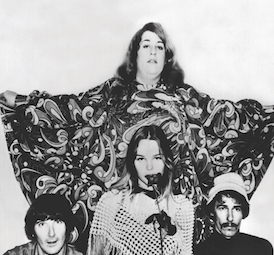
When Bernstein promoted the Beatles’ performances in Shea Stadium last summer, the show grossed $250,000, but Bernstein ended up with a net loss of $680. “The Beatles are quite wise not to come back,” said David Crosby of the Byrds, another group which is weary of touring, sick of being screamed at, and would rather record albums at home. “If the Beatles toured America now there’d be a lot of empty seats. The same with the Stones. The kids aren’t going to pay all that money for another 29-minute show in a ball park. They’ve seen those four dots before.”
There are some American groups, like Paul Revere and the Raiders, that are capable of going on the road and drawing well, but even they are beginning to look at their music and wonder if it’s good enough. “Look down the list,” says one rock-’n’-roll booking agent. “It’s all the same story. Mitch Ryder and the Detroit Wheels, another giant of personal appearances, have disbanded, and Mitch Ryder is touring with a 10-piece orchestra. Herman’s Hermits? Still strong but dwindling. The Supremes wouldn’t look at a one-nighter; they’ll do the good nightclubs and good TV. Petula Clark, who may be the No. 1 female vocalist, is working in a movie. Simon and Garfunkel? Colleges and concerts, probably the best duo around. Donovan? He’s Alexander the Smooth, England’s Bob Dylan. He has a lot of hit records and a big underground following, but he just canceled an American tour.”
As for Dylan, probably the most influential voice in contemporary music, the industry is still waiting for his next move. In Woodstock, New York, where he is convalescing from a broken neck suffered in a motorcycle accident, Dylan remains mysteriously incommunicado. He is writing at least 10 new songs a week, rehearsing them with his band, and completing a one-hour TV special. He also is growing a beard.
From San Francisco, where music is being mixed with psychedelic light shows, and dance halls like the Fillmore Auditorium are packing thousands into what its owner calls “a party scene,” the new sound of groups such as the Moby Grape, the Jefferson Airplane, and the Grateful Dead, featuring a 200-pound bearded singer named Pig Pen, is making its claim on the pop-music future. In London, Beatles’ manager Brian Epstein is concentrating on the Lomax Alliance, the first major Anglo-American pop group, and the Bee Gees, whom he optimistically labels the biggest thing since the Beatles. In New York, the management firm of Albert B. Grossman, fueled by the power of clients such as Bob Dylan, and Peter, Paul and Mary, is pushing folk-rock singer Richie Havens, and the Paupers, a new quartet from Toronto, which is becoming one of the music capitals of North America.
“It’s as if everybody’s done everything,” said one rock guitarist, “and it’s getting harder and harder to think of new things to do.”
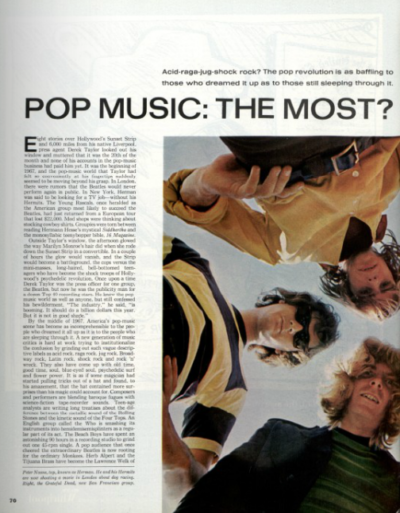
There are some observers who look upon the current aches of the business as mere growing pains. And a good case can be made for signs of approaching adulthood. Pop has begun to throw off the flummery of Moon and June, and increasingly is singing songs of life, death, existence, heroism, and mystery. It may be in danger of becoming too self-conscious, but there is no denying its positive virtues: Never before has music been so complete an expression of its time or been so knowing of the needs of its audience. The fans who once trampled one another just to see their heroes are now listening to them.
Where is pop going? Well, this year the record industry should gross, as Derek Taylor said, about $1 billion, a tidy sum in any industry, whatever the surface confusion. And beneath that surface there are stirrings. There is a push among the best of the rock and pop stars toward quality. The competition among the best — Bob Dylan, the Beatles, the Rolling Stones among them — is no longer for money. They already have enough of that. The competition is in music.
By the summer of 1967, even press agent Taylor had decided to give up his dozen Top 40 clients to concentrate on quality. “I became bored,” he explained. “I became bored with a performer’s pet loves, and pet hates, and what he eats for breakfast. The best artists in the business — the aristocracy — are moving into positions of power. They’re making fewer and fewer compromises with commercialism. There’s hardly anything interesting happening outside this exclusive circle. But what’s happening inside may be the most remarkable story of our time.”
This article is featured in the July/August 2017 issue of The Saturday Evening Post. Subscribe to the magazine for more art, inspiring stories, fiction, humor, and features from our archives.
Love and Haight: The 50th Anniversary of the Summer of Love
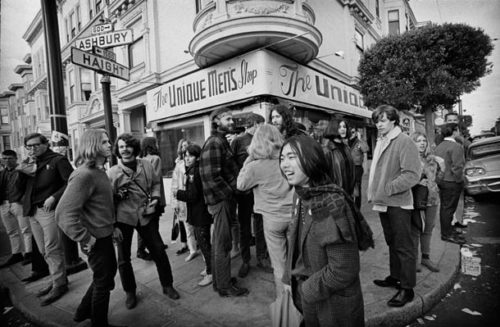
How best to sum up an acid-inflected, flower-powered, whirligig of a long-ago summer in San Francisco? How to understand the lasting impact of that summer, which took root in a full-on Age of Aquarius neighborhood and blossomed into a counterculture that splattered across the planet?
Perhaps it’s fitting to begin by describing its final day.
On October 6, 1967 — exactly one year after California lawmakers voted to ban the drug LSD — several hundred young bohemians gathered in the City by the Bay for what had been advertised as “The Death of the Hippie” funeral. Surviving film footage depicts a surprisingly carnival-like atmosphere. There was dancing in the streets. Someone played “Taps.” Sullen pallbearers carried aloft a large coffin that bore a single inscription: “Hippie, Son of Media.”
And that, ladies and gents, is how — officially and weirdly — the so-called Summer of Love concluded. Groovy.
The woman who organized the mock funeral, Mary Kasper, explained that following a season of merriment, music, confusion, and ultimately chaos in the streets of her city’s Haight-Ashbury district, “we wanted to signal that this was the end of it … don’t come here because it’s over and done with.”
Where once The Haight was iridescent with tie-dyed fabrics, colorful blooms, psychedelic storefronts, and a heady pharmaceutical culture, it had become, by October of ’67, a gritty tourist attraction. Worse, it had devolved into a magnet for thieves who’d descended from all around to prey on the vulnerable longhairs who had overstayed their welcome.
The Summer of Love, as initially conceived, was a brilliant marketing scheme. It was intended from the outset to be a convulsion of music, sex, and radical nonconformism. Come to The Haight to “turn on, tune in, drop out,” as Timothy Leary, the high priest of West Coast psychedelia, often exhorted his acolytes.
So, you might fairly ask, was the allure for young Californians the easy access to mind-altering drugs and sex?
Or the throbbing psychedelic music?
Or was it the gathering of the district’s anti-Vietnam War activists?
Yes.
Against the backdrop of a country in turmoil, here would be an aphrodisiacal admixture that some 100,000 people would find too tempting to pass up.
The whole thing sprang to life easily enough in the vibrant tapestry of The Haight, but by the time of the symbolic Hippie Funeral, the Summer’s mixed-up, mixed-media message had wafted across America and far beyond. The hippieverse had metastasized into a veritable, if not universally embraced, worldwide phenomenon.
From New York to London to parts of Asia, the hippie lifestyle was observed by onlookers with a combination of amusement and condemnation. It was a thing of kaleidoscopic beauty, to be sure, but some also thought it was a thing reeking of despair.
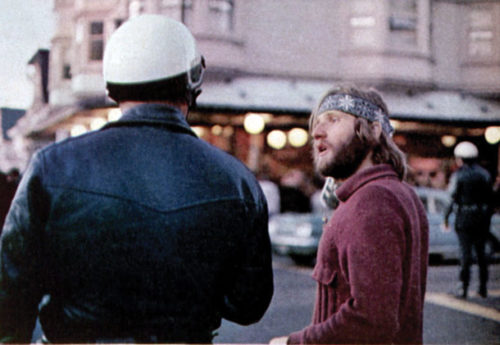
Ted Streshinsky, © SEPS
Today, 50 summers on, the questions remain: “What the hell was that all about? Was it, like, too far-out, bro?”
Those were the first questions I put to Dan Lewis, a Northwestern University social-policy professor and proud former hippie. Lewis will oversee the school’s Summer of Love Conference, taking place this July in San Francisco. “Over the years, I’ve been trying to make sense of that period,” Lewis told me when we talked. “There have been all these snarky, nasty, make-fun-of-kids-who-were-stoned people,” he said with an undisguised tone of contempt.
No matter what you may think of the Summer of Love, said Lewis, who runs Northwestern’s Center for Civic Engagement, what happened during that brief season has had a lingering influence on our way of life. For example, it led to the development of Silicon Valley.
Excuse me? You heard that right. According to Professor Lewis, some of the research (not his) that will be presented at the conference will trace “a lot of early thinking about information and communal groups and how that evolved into the Whole Earth Catalog, and then the internet, and then into cyberculture and eventually Silicon Valley.” The hippies are to blame for our smartphones! Well, sort of. And for the record, Lewis swears he no longer drops acid.
Actually, without too much of a stretch, you can make a pretty credible case for the argument: The deployment of social media on a global scale, pioneered by Facebook, was foreshadowed by what happened in 1967 at the intersection of Haight and Ashbury streets, where once stood the funky Unique Men’s Shop.
When I asked around among people who were there at the time — all of whom boasted that they still retain their hippie ideals, if not the iconic wardrobes — the underlying theme of that summer was not free love or LSD or rebellion against the distant war as expressed in the music. It was, fundamentally, a simple, sweet sense of community.
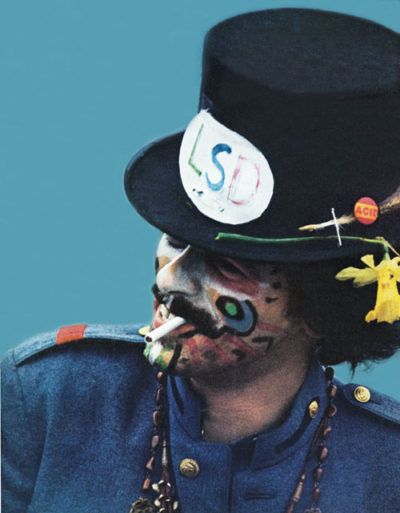
Ted Streshinsky, © SEPS
Among the astonishing catalogue of memorable songs that marked the summer of ’67 (“Good Vibrations,” “Like a Rolling Stone,” “White Rabbit,” “Bad Moon Rising,” “Light My Fire,” and “Sgt. Pepper’s Lonely Hearts Club Band” are but a sample), I was told over and over again that it was the Youngbloods’ “Get Together” that most perfectly captured the spirit of The Haight:
Come on people now,
Smile on your brother,
Everybody get together,
Try to love one another right now
Consider: It may have taken a while, but it was left to Mark Zuckerberg — not yet born in ’67 — to figure out how to connect latter-day hippies — and practically all other living persons — into a true worldwide community where everyone could in fact “get together.” Facebook, one might contend, is the natural evolutionary product of what the Youngbloods and their fans started.
In part because the hallucinogens raised consciousness (though not always mental acuity), hippies left us other gifts besides their remarkable music. The notion of recycling, for example. Scott Guberman, who plays in a Bay Area band with Phil Lesh of The Grateful Dead, told me that “the idea of recycling garbage came from the Summer of Love. The hippies were always concerned about sustainable living.” The whole organic movement, too, according to Guberman. But wait, there’s more. Credit the hippies for yogurt’s success in America because, Guberman told me, they “popularized” the treat.
It’s somewhat easier to link the lifestyle of the hippies to medical research now under way to use hallucinogens to help people quit smoking, break free of addictions, overcome depression, and more. For a long time, as a backlash to the recreational uses of these drugs, it was very difficult to get access to them for such research, but in recent years, that’s been changing. According to The New York Times, for example, such reputable institutions as New York University and Johns Hopkins University are studying the potential of psilocybin, the active ingredient in psychedelic mushrooms, to help terminal cancer patients face up to and accept their mortality.
If, in 1967, hippies “perceived these illegal drugs as a sacrament which was taken to achieve spiritual enlightenment,” as William Schnabel wrote in his book Summer of Love and Haight, they could never have imagined how legalized forms of these same substances would one day be sought by thousands of ailing patients. The apothecary that was The Haight helped give birth to these important scientific breakthroughs.
It also, unfortunately, led to serious issues with abuse of opioids. Sheila Weller, who has written extensively about the Summer of Love in Vanity Fair, said to me in a text message that “the mindset has endured a lot. … Taking drugs became hip, and the kids who could rebound and go back to their lives and their educations were the middle- and upper-class kids. The lower-class kids have spawned a second or third generation of opioid addicts.”
Lost in all of this is a small but telling irony. A free clinic that opened in The Haight in 1967 — it was designed to help heroin addicts — has recently been absorbed into a multimillion-dollar medical conglomerate named (wait for it) HealthRIGHT 360. Very corporate.
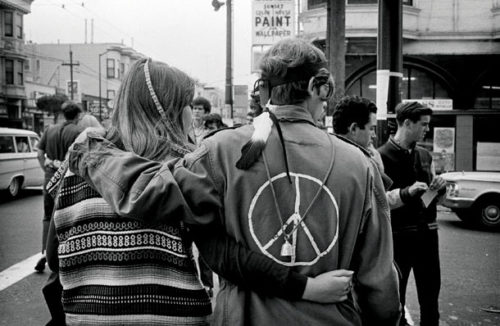
Jim Marshall Photography LLC
In many ways, the ’60s was a pivotal decade in American history — let’s just stipulate to that point and move on — but 1967 was the year of ultimate highs (pun intended). The celebrating and the innovating were likely connected, less by networking than by LSD and the Panama Gold grass, which could be easily had at the “happenings” and “Be-ins” in the shadow of the Golden Gate Bridge.
“All the creativity, the experimentation, the music — hell, ’67 was when we saw the rise of FM free-form radio and its influence,” Neal Mirsky, a longtime rock-radio program director, told me when we sat down to discuss the era. “It’s the first time we even looked at popular music as art. It was just such a transformational time in a lot of ways.”
The Haight, not surprisingly, was a sort of ground zero for all that. Writing not long ago about a concert that occurred one night in the neighborhood’s famed Fillmore Auditorium, San Francisco Chronicle critic Joel Selvin observed, “Everybody who found their way there knew how wonderful the whole thing was and immediately embraced everybody else as fellow members of a special secret society.”
Vivian Murray, who was a high school kid hanging in The Haight during the summer of ’67, remembers that, for her crowd (and presumably Janis Joplin, who briefly lived in the same apartment building), the Summer of Love was driven not so much by utopian ideals but rather by an inchoate urgency to break away from The Man. In essence, to join that special secret society. “It was just our way of gaining freedom. The music scene had a huge effect. We’d escape into that.”
Alas, Murray, who went on to work a series of jobs, including in property management, doesn’t think the spirit of that summer will ever be resurrected. “We were into peace and love. Today’s kids are into video games: action, violence!”
In an effort to hold on to those memories, Murray maintains a Summer of Love shrine in her Washington State home — a room decorated with period furnishings and art. “And I still have my hippie beads,” she told me proudly. Old hippies die hard.
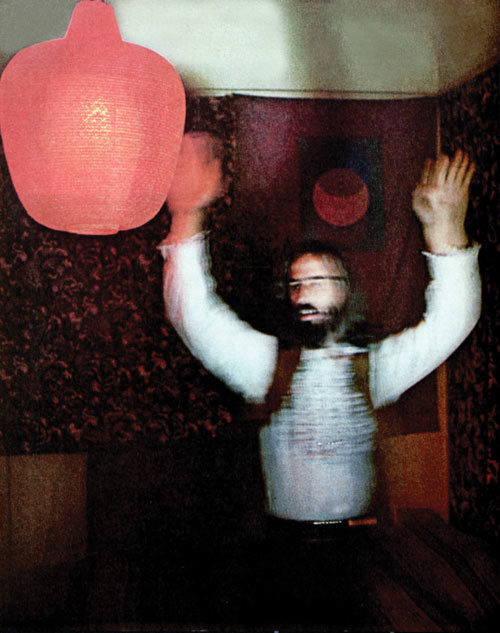
Ted Streshinsky, © SEPS
Witness Joe Tate, who was lead guitarist in Salvation, a psychedelic rock band that performed around San Francisco in the ’60s. Tate, who today continues to dress “like an unkempt hippie,” currently lives north of the city, in Sausalito. He boasted, “I still feel the same way about everything. I didn’t turn into a conservative. I see injustices every day.”
“Any chance of a hippie resurgence someday?” I asked. Unlike Vivian Murray, Tate is decidedly optimistic. “It could happen,” he said. Turns out he’s one among probably many thousands who’d welcome a hippie redux. When a British-based group organized for the purpose of celebrating the Summer of Love’s 50th anniversary — there are scores of such groups, thanks to the internet — it posted all its plans. On Facebook, of course. The final agenda item was an immodest throwback to 1967: “Save the world.”
Neato.
Cable Neuhaus writes about popular culture for the Post and other publications.
This article is featured in the July/August 2017 issue of The Saturday Evening Post. Subscribe to the magazine for more art, inspiring stories, fiction, humor, and features from our archives.
A Father Remembered: The Acting Coach
Theater was my father’s religion, and Shakespeare’s works were his Bible. Using Hamlet or Othello or King Lear as a moral compass, Dad set me up with some precise ideas about how a person should behave in the world.
As a young man, my father studied at the Goodman Theatre in Chicago. He came to New York at the height of the Depression, but within months he landed parts in daytime radio serials such as Myrt and Marge, Valiant Lady, and The Goldbergs. He was sometimes doing two or three live performances in a day, zipping across town from one studio to the next in taxis.
His dream was to perform on Broadway, and he would brim with emotion as he described the great stage actors he’d seen, such as the Lunts and a young Olivier. As for his radio work, that was just something he had to do to pay the bills.
By the time I was born, he had exited show business for a more stable career, but, as far as we kids knew, that was just a technicality. He would always be an actor at heart. Where other dads might sing in the shower, ours would recite from Hamlet. “What is Hecuba to him, or he to Hecuba, that he should weep for her?” he would declaim in his stage voice — big enough to carry to the cheap seats, but in this case echoing through our New York apartment and, if the bathroom window was open, into the courtyard as well. He was bigger than life.
At a young age, I decided that I, too, would become an actor. My first big performance was in a school play. Our fifth-grade class had spent the whole semester studying the ancient Greeks. We had read young-adult versions of The Iliad and The Odyssey, and now we were performing an adaptation of an Aristophanes play, in which a farmer travels to heaven astride a giant dung beetle to discuss the follies of war with, well, you know, the big guy, Zeus. I was the leader of the chorus, and one day during rehearsal I slipped and fell. Amazingly, this got a big laugh.
We performed the play for the entire school — parents, too. I mugged my way through my scenes and, for my big finale, I upended myself spectacularly to roars of laughter. I was hilarious!
Mom came backstage to give me a hug, but Dad had left the theater early. It wasn’t until I got home that I had any inkling there was a problem. Still aglow from my smashing success, I rushed into the living room, only to find him seated in his chair, wearing his reading glasses and holding a large volume on his lap. He didn’t look up when I came in. A frown creased his forehead.
“Sit down,” he ordered, beckoning me to a second chair he had pulled up beside him. Seems I had violated just about every code of conduct in the actor’s book, from scene stealing to shameless overacting. He opened up The Complete Works of Shakespeare and turned to Hamlet’s advice to the players, Shakespeare’s master class on the actor’s craft.
He began reading: “Speak the speech, I pray you, as I pronounced it to you, trippingly on the tongue. … O, it offends me to the soul to hear a robustious periwig-pated fellow tear a passion to tatters. … I would have such a fellow whipped.”
This, my friends, is the short version. The soliloquy actually goes on a bit. He read me the whole thing. Then he had me read it — the equivalent in our house of being taken to the woodshed. Finally he let me go.
I was deflated, but it was a lesson that would stick with me, and, as I would realize in later years, Shakespeare’s words apply not just to the stage, but to life. In short: Be funny, but don’t be a clown; be smart, but don’t be a smart aleck.
I can’t say I’ve always followed this wise counsel, but when I feel the urge to show off, Hamlet’s advice to the players is always right there on my bookshelf.
Steven Slon is the Post’s editorial director. Follow him on Twitter.
This article is featured in the May/June 2017 issue of The Saturday Evening Post. Subscribe to the magazine for more art, inspiring stories, fiction, humor, and features from our archives.
How One Executive Order Devastated the Country
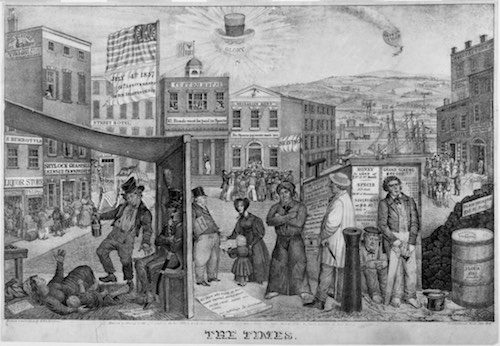
One of the worst economic panics in the U.S. was caused by a president’s executive order.
In the 1830s, America enjoyed a robust economy. Cotton prices were high, and there was a booming market in Midwestern land. Between 1834 and 1836, land sales jumped 500 percent.
Speculators were grabbing up land at bargain prices and paying with bank notes from unregulated state banks, which often didn’t have enough coin to back up those notes. Consequently, the value of a note of the same denomination might vary wildly from one bank to another. (As a service to businessmen, the Post regularly reported the fluctuating values of several important bank notes.)
Andrew Jackson worried that too much federal land was being bought with over-valued paper dollars. Remembering how his Tennessee constituents lost their fortunes in the Panic of 1819 because of land speculation and bank failures, he didn’t trust banks and he despised speculators.
As one of his last acts in office, in 1836, Jackson took action with an executive order — the Specie Circular — which required all future land sales to be paid in specie: gold or silver coin.
Suddenly, specie was in great demand, and banks couldn’t get enough of it. A specie shortage led to the collapse of the land market. The value of gold rose while the value of paper dollars fell, and bank customers began withdrawing their money in coin to avoid losing their savings, which only worsened the specie shortage.
Acknowledging that they no longer had enough hard assets to cover their bank notes, the banks of New York, on May 10, 1837, stopped paying depositors in specie. The New York decision started a run on banks across the country as hundreds of thousands of Americans tried to withdraw their money from banks. Following the example of New York, 800 banks across the country stopped paying in specie. Some states tried to shore up their economies by issuing bonds to support the banks, but the states defaulted on the bonds and had to declare bankruptcy. The money supply was reduced to a trickle.
Before the year was out, almost half of America’s banks had failed. Unemployment rose sharply — reaching 25 percent in some areas — and profits, prices, and wages fell. The Panic of 1837 had begun.
It took seven years for the U.S. economy to resume its former growth.
Jackson’s Specie Circular wasn’t his only contribution to the Panic. It was compounded by his decision to shut down the Bank of the United States. In 1836, he fulfilled a campaign promise to withdraw federal funds being held by the bank.
This action was also part of Jackson’s grudge against all banks. He believed the Bank of the United States, in particular, was too powerful and run by elites to benefit themselves. Just before he left office, he withdrew millions in federal funds and deposited them in state banks, many of which were unregulated.
Had the Bank of the United States still been operating in 1837, it might have been a steadying influence in the financial sector. It might have helped in the distribution of specie instead of letting it collect mostly in eastern banks. And it might have reassured the country that a strong, well-regulated, central bank was still conducting business.
Jackson’s moves against banks weren’t the only causes of the Panic of 1837, though. Another large factor was Great Britain’s move to stop British gold flowing into American investments. Not only did this throttle foreign investment, but it forced American banks to raise interest rates.
But Jackson must bear the greater responsibility for letting his fear of banks get the better of him, and of the country.
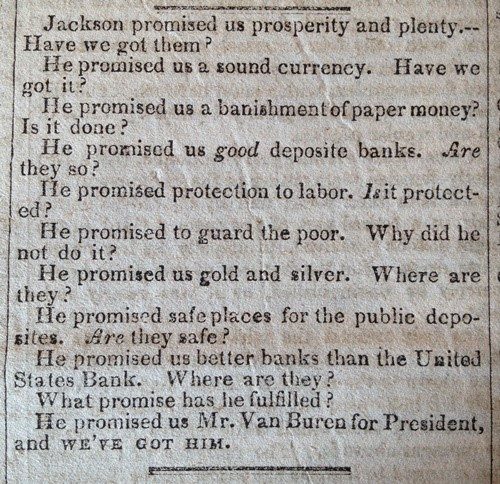
Fortunately for Jackson, he was able to dodge most of the blame. As often happens, the consequences of one president’s poor judgment become the responsibility of his successor. The New York banks’ specie policy was announced just five weeks into Martin Van Buren’s presidency, and he had to take the heat for Jackson’s policies.